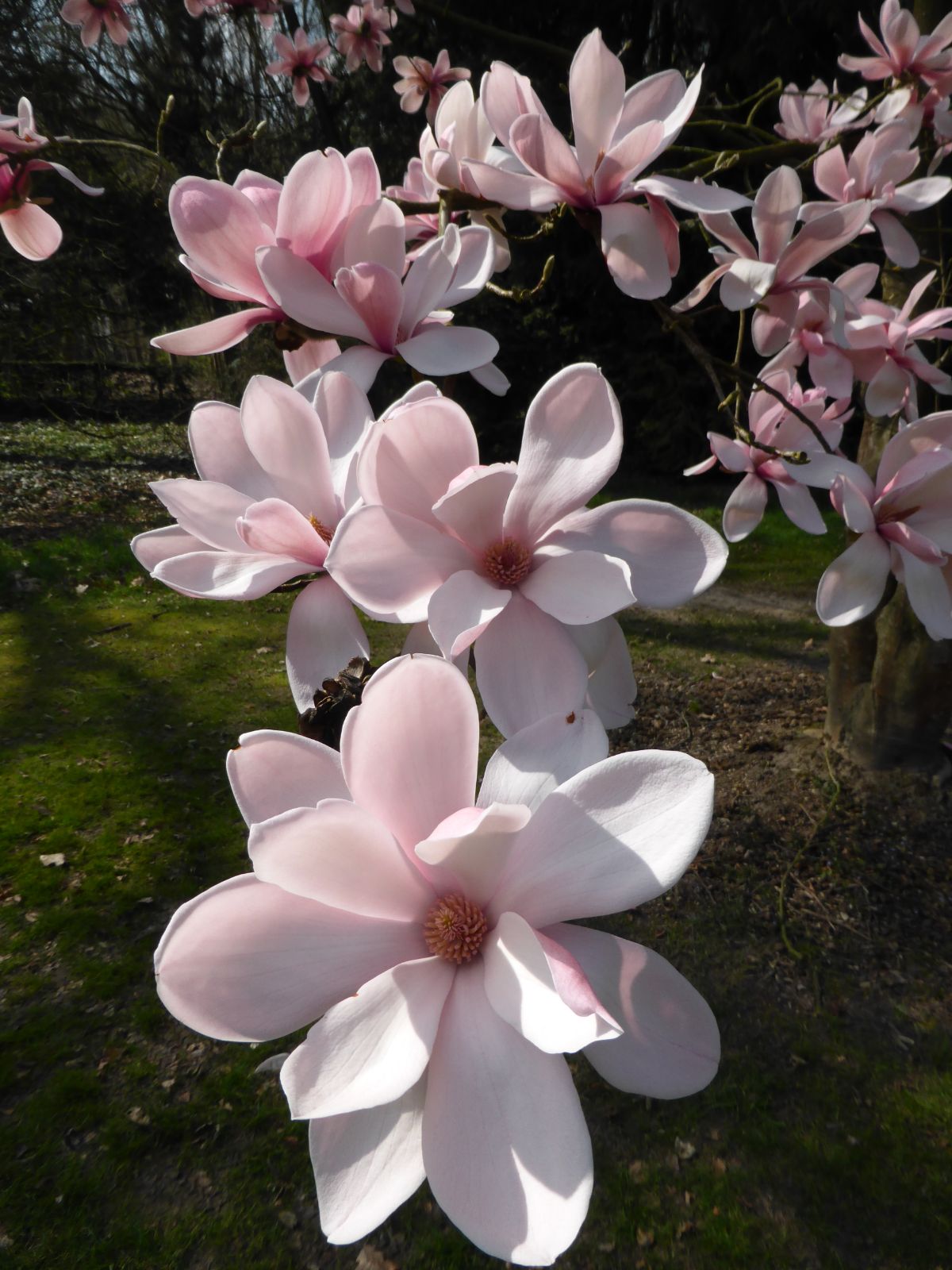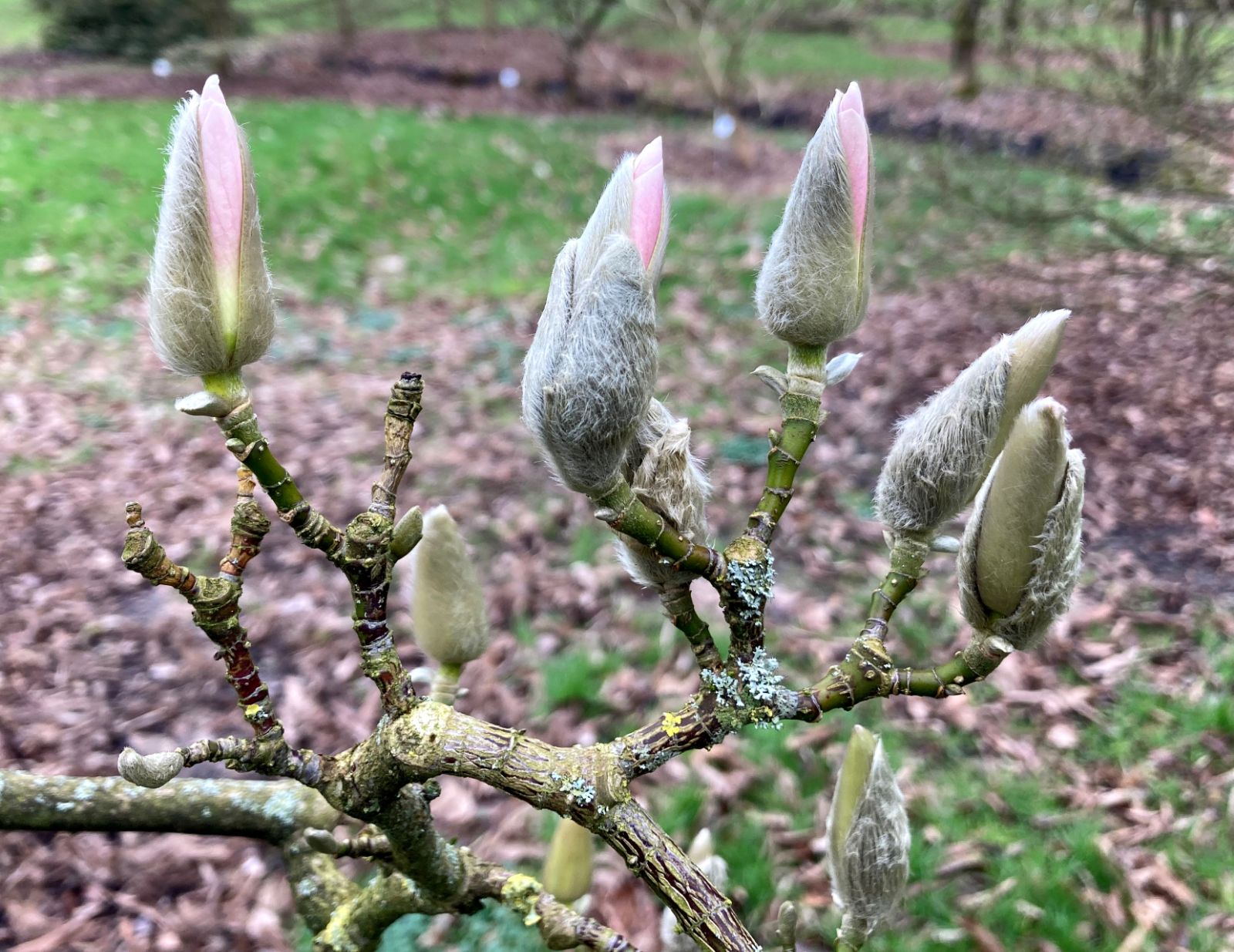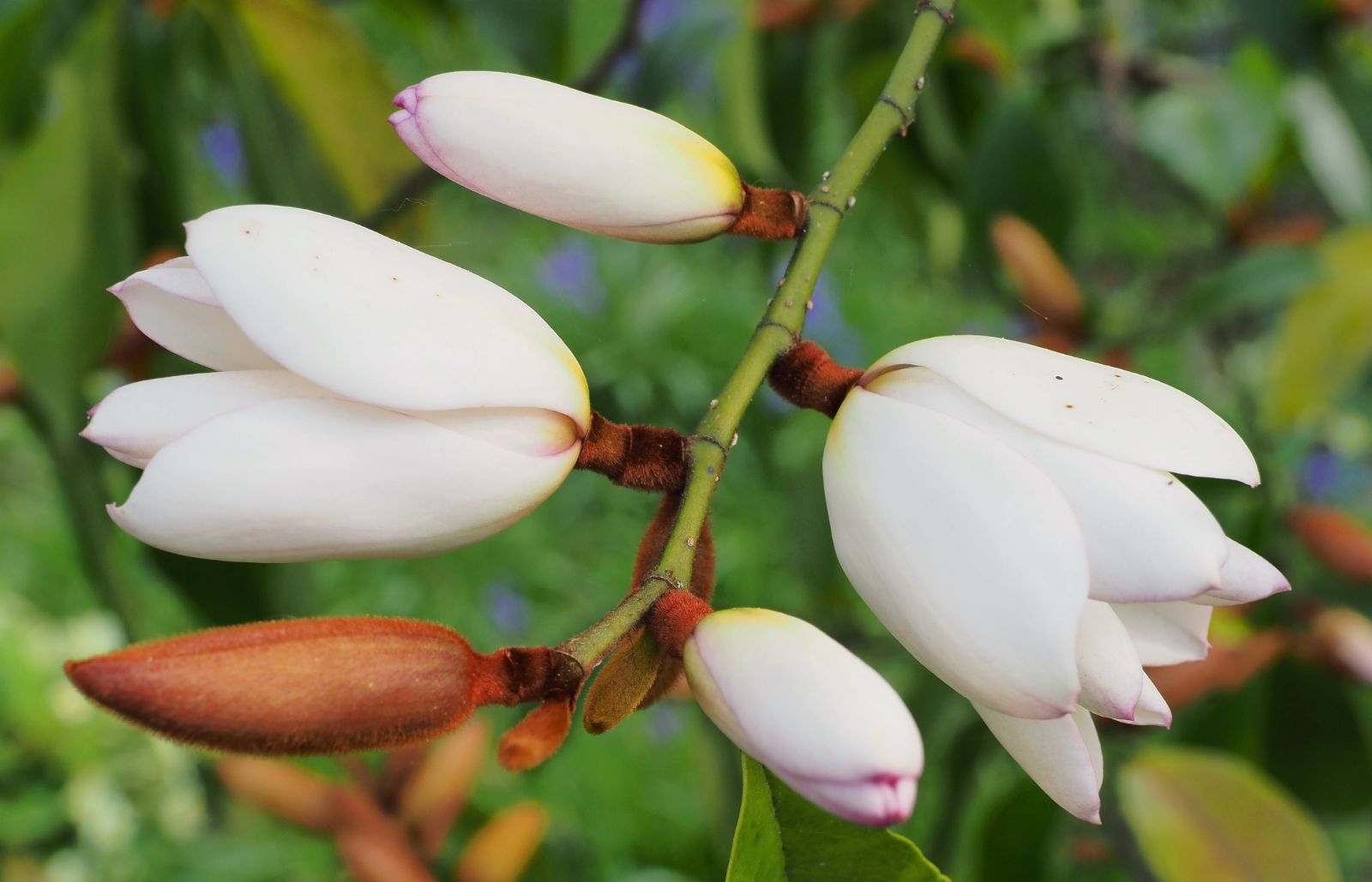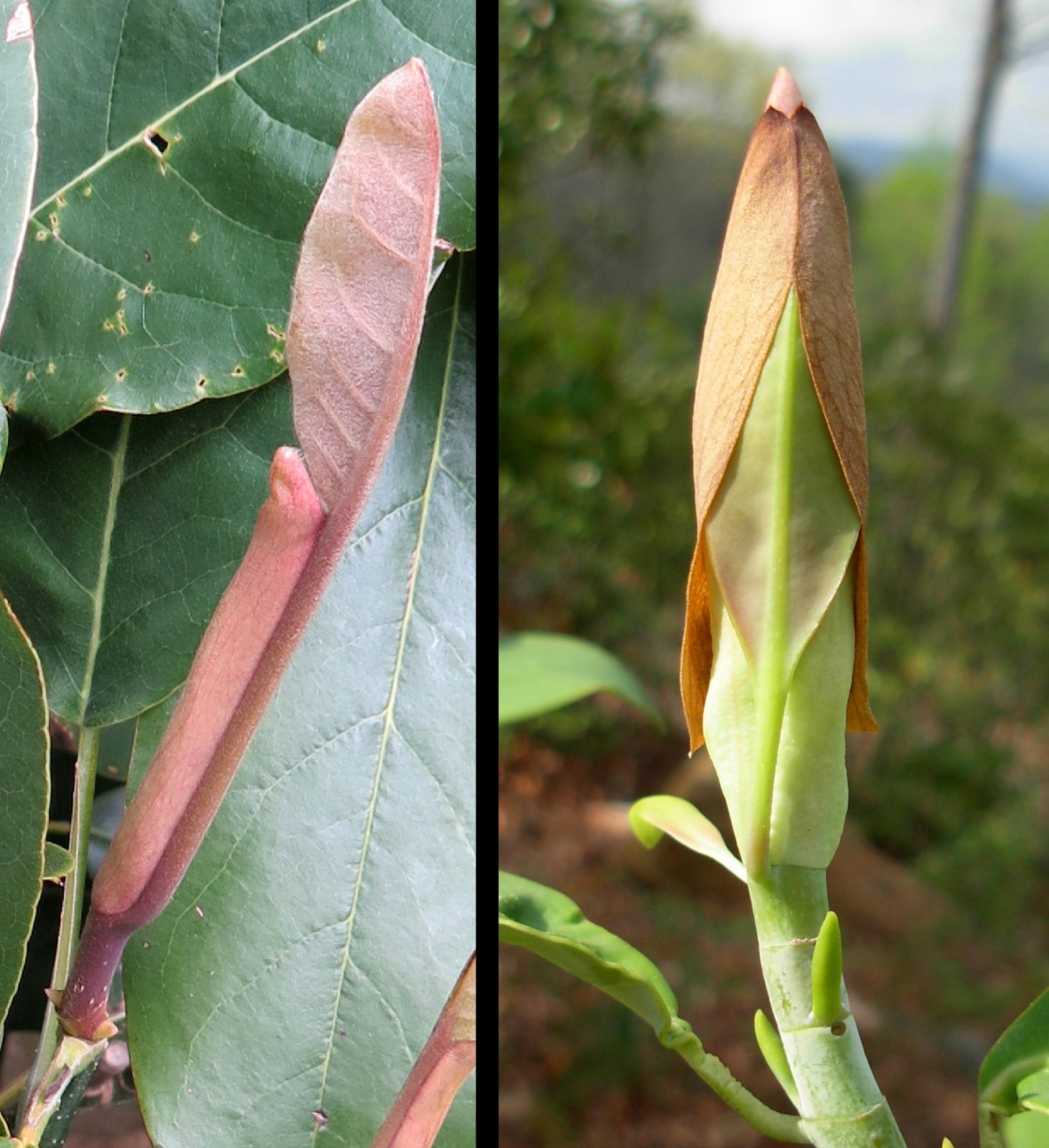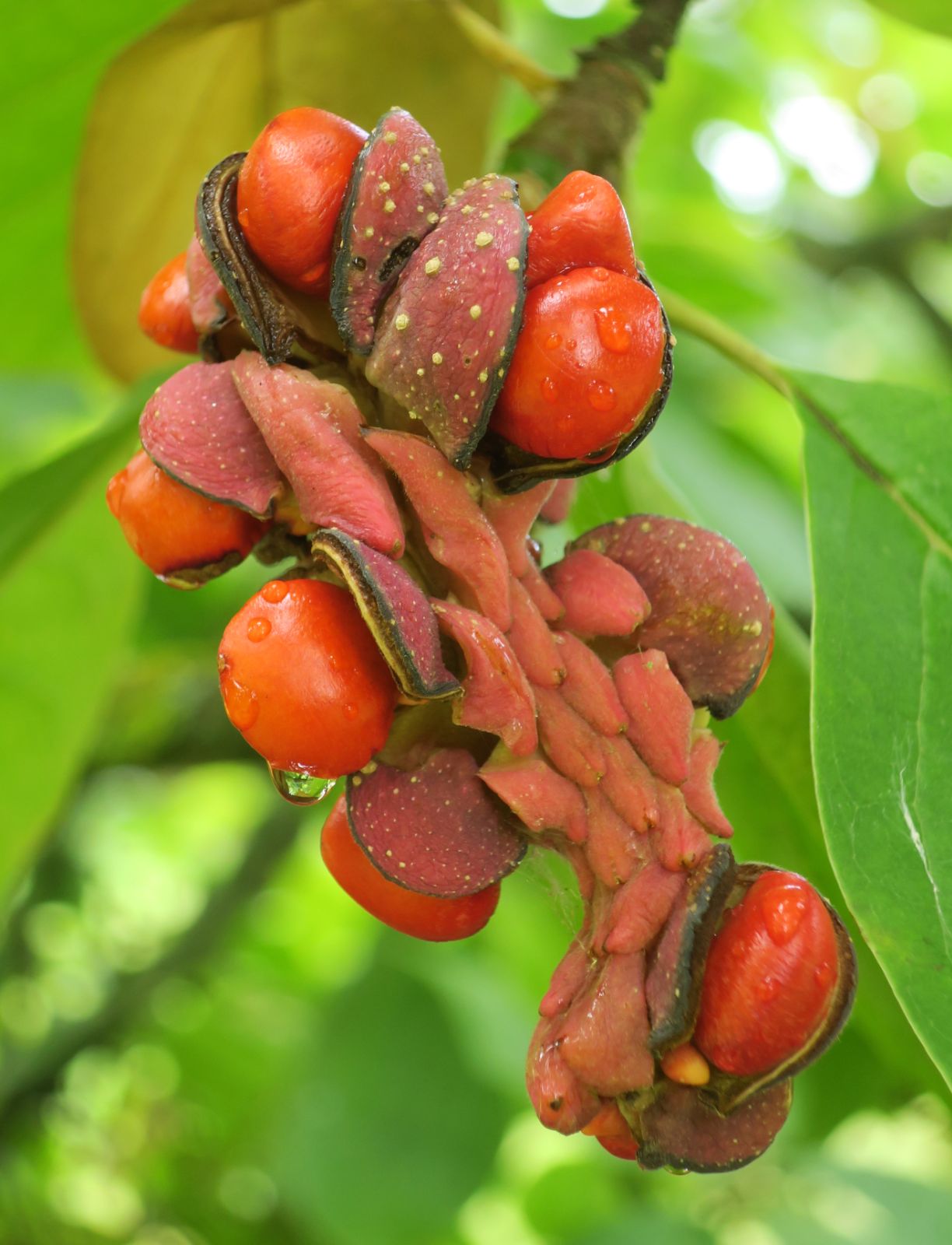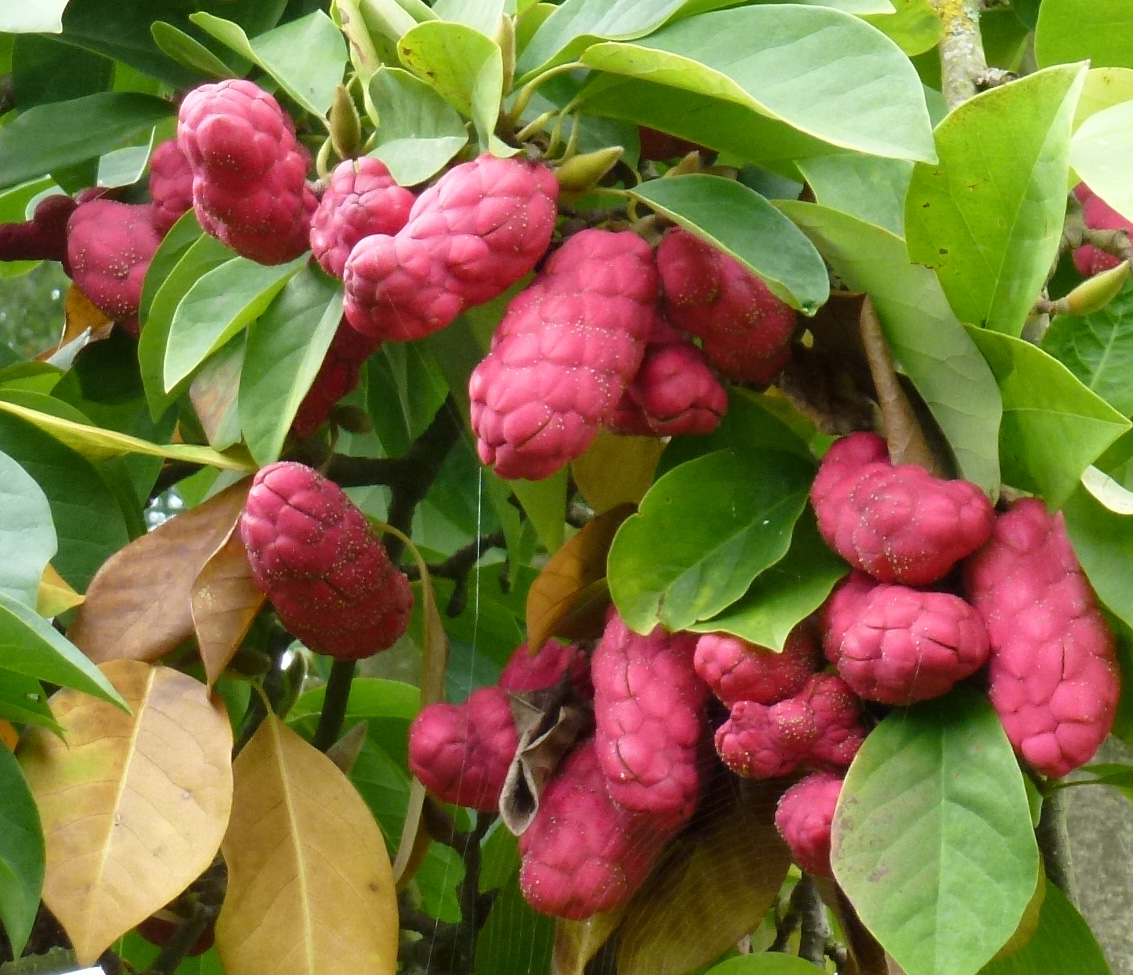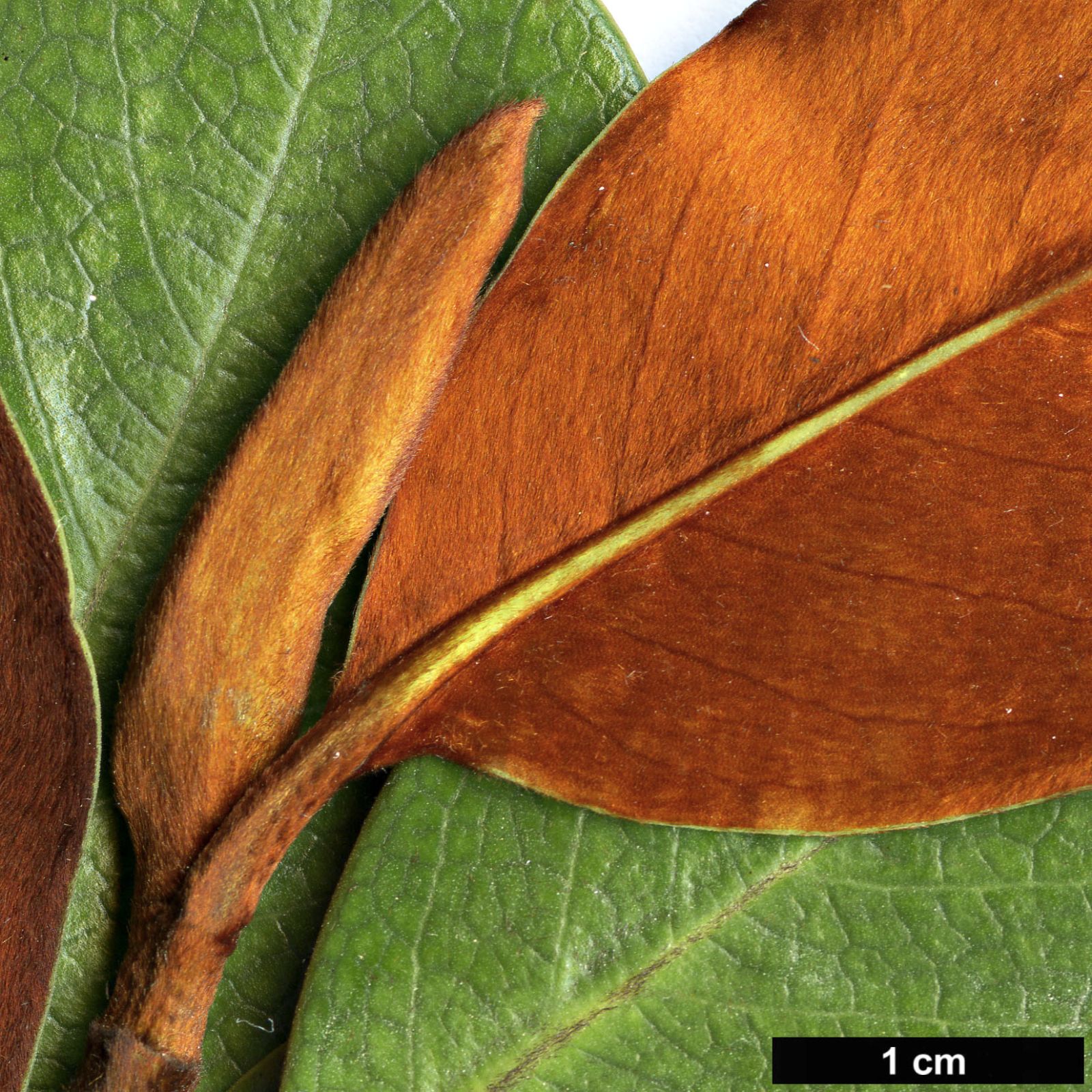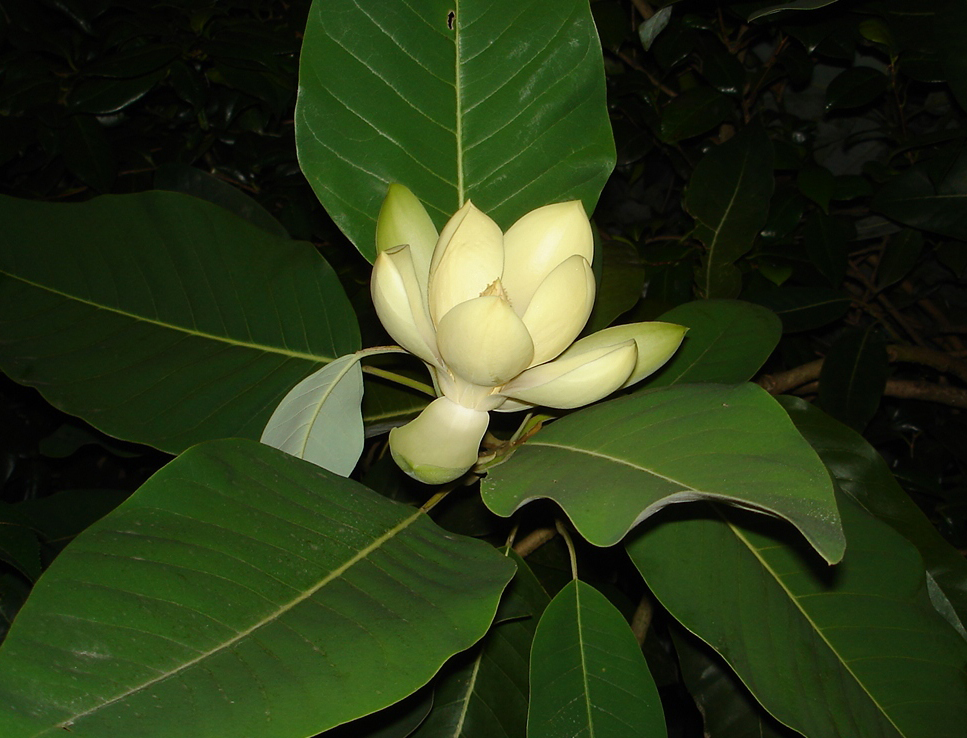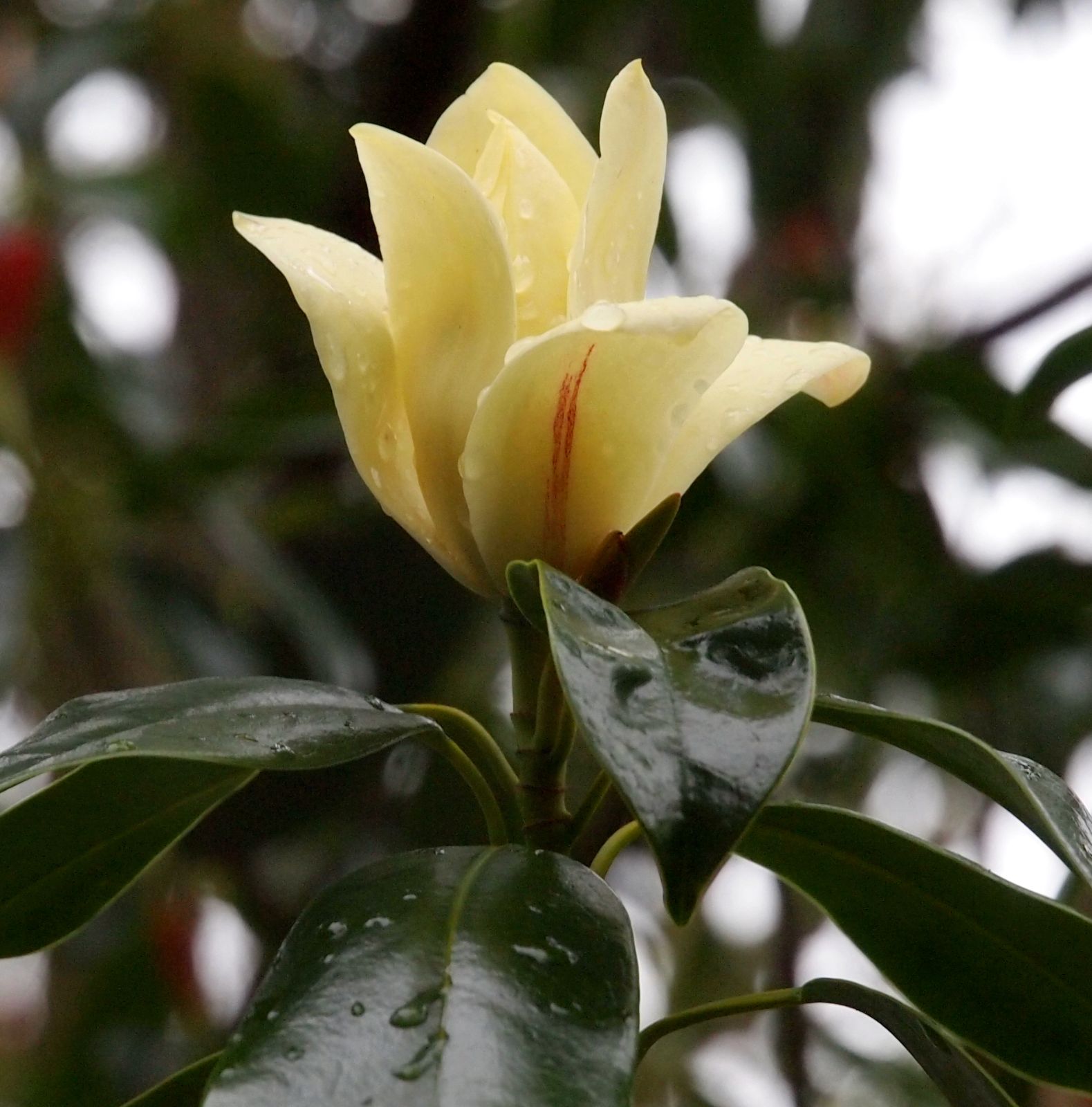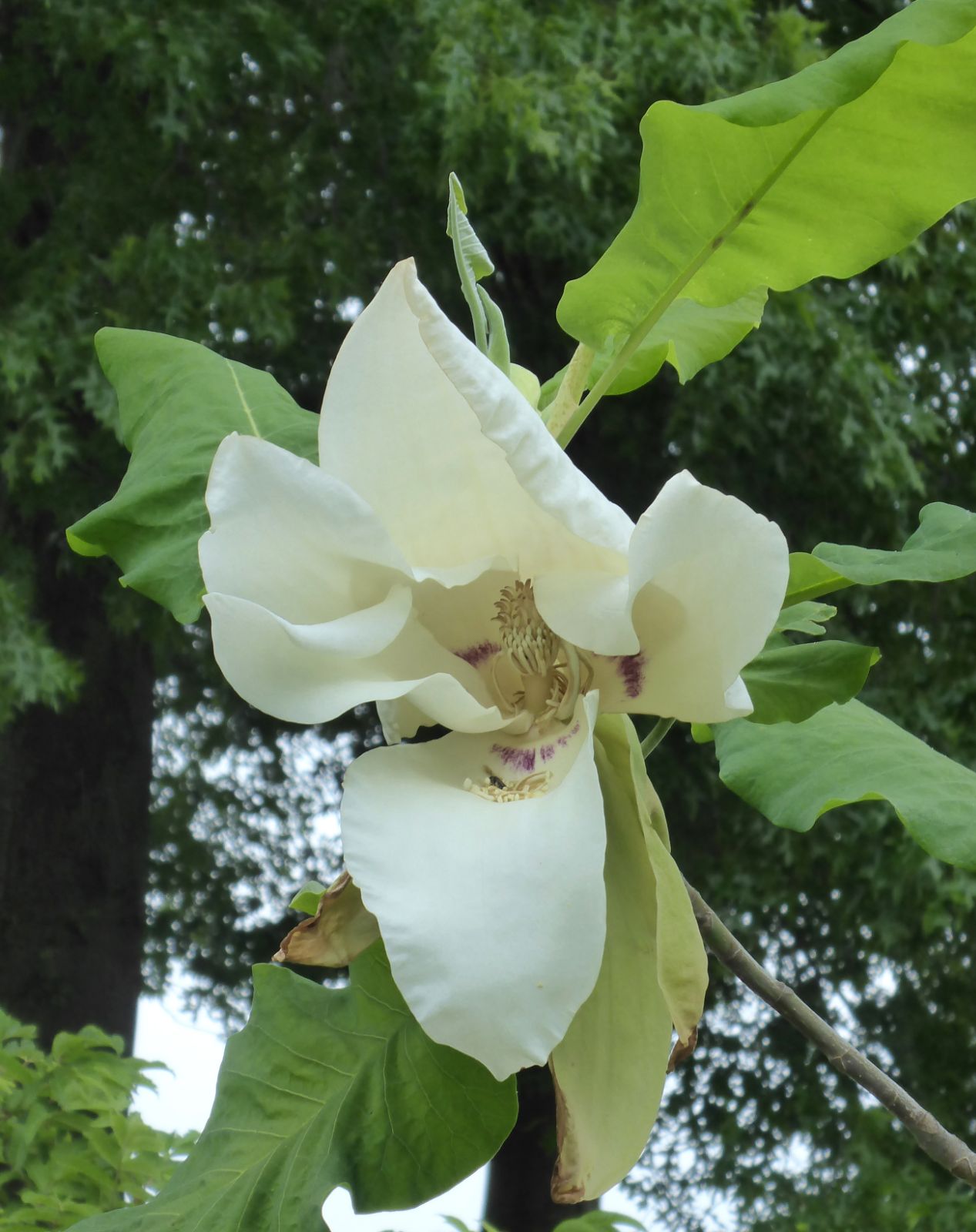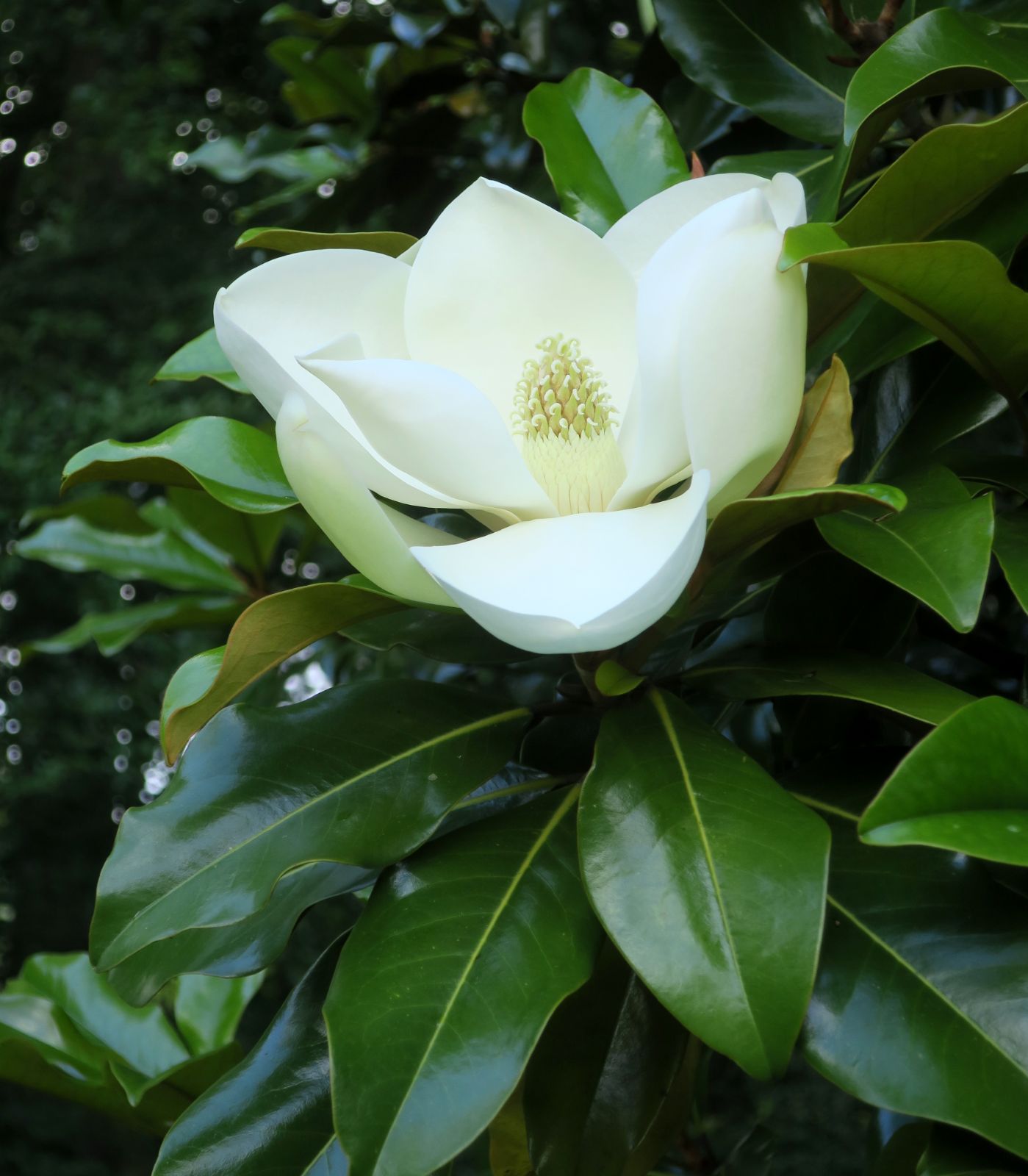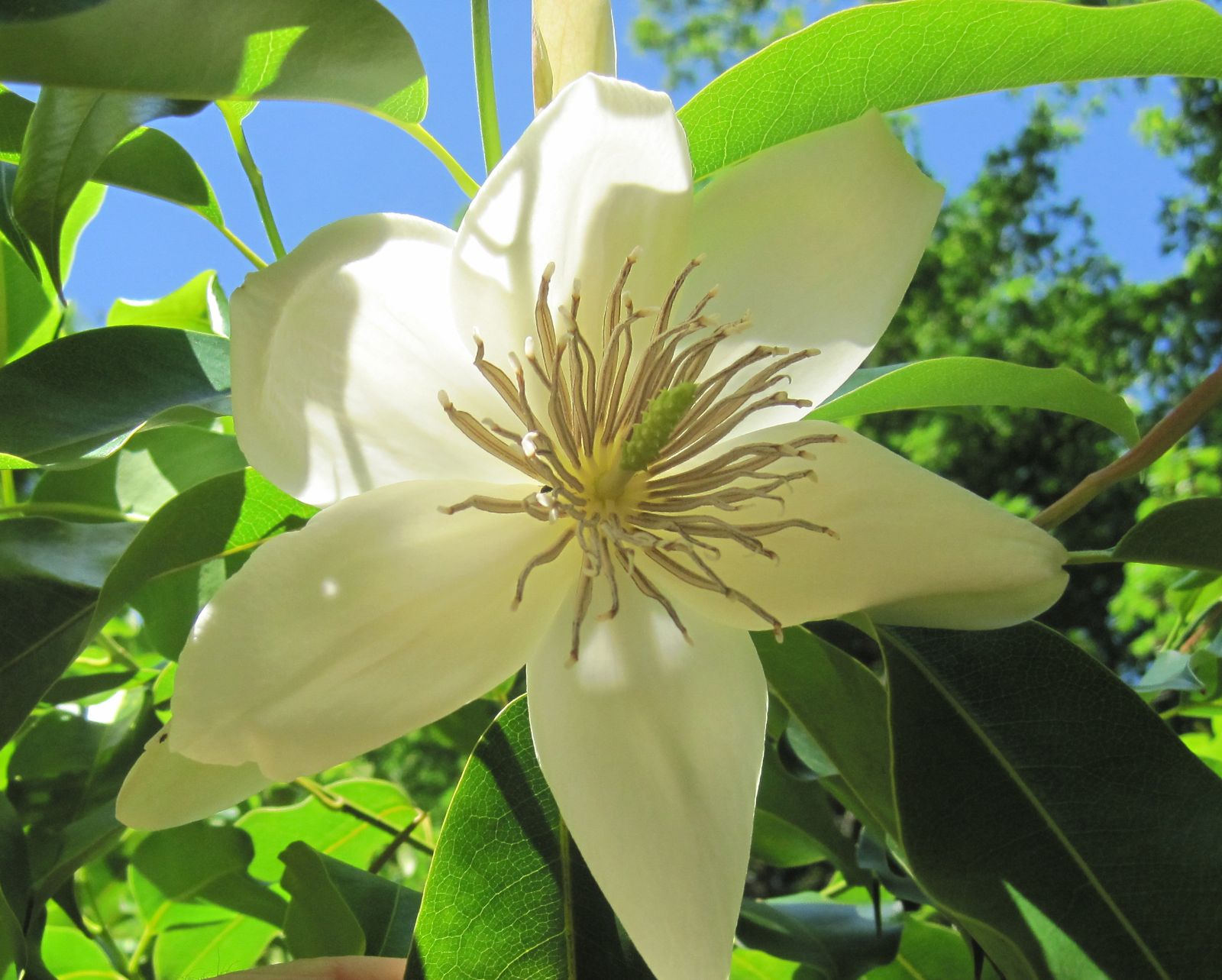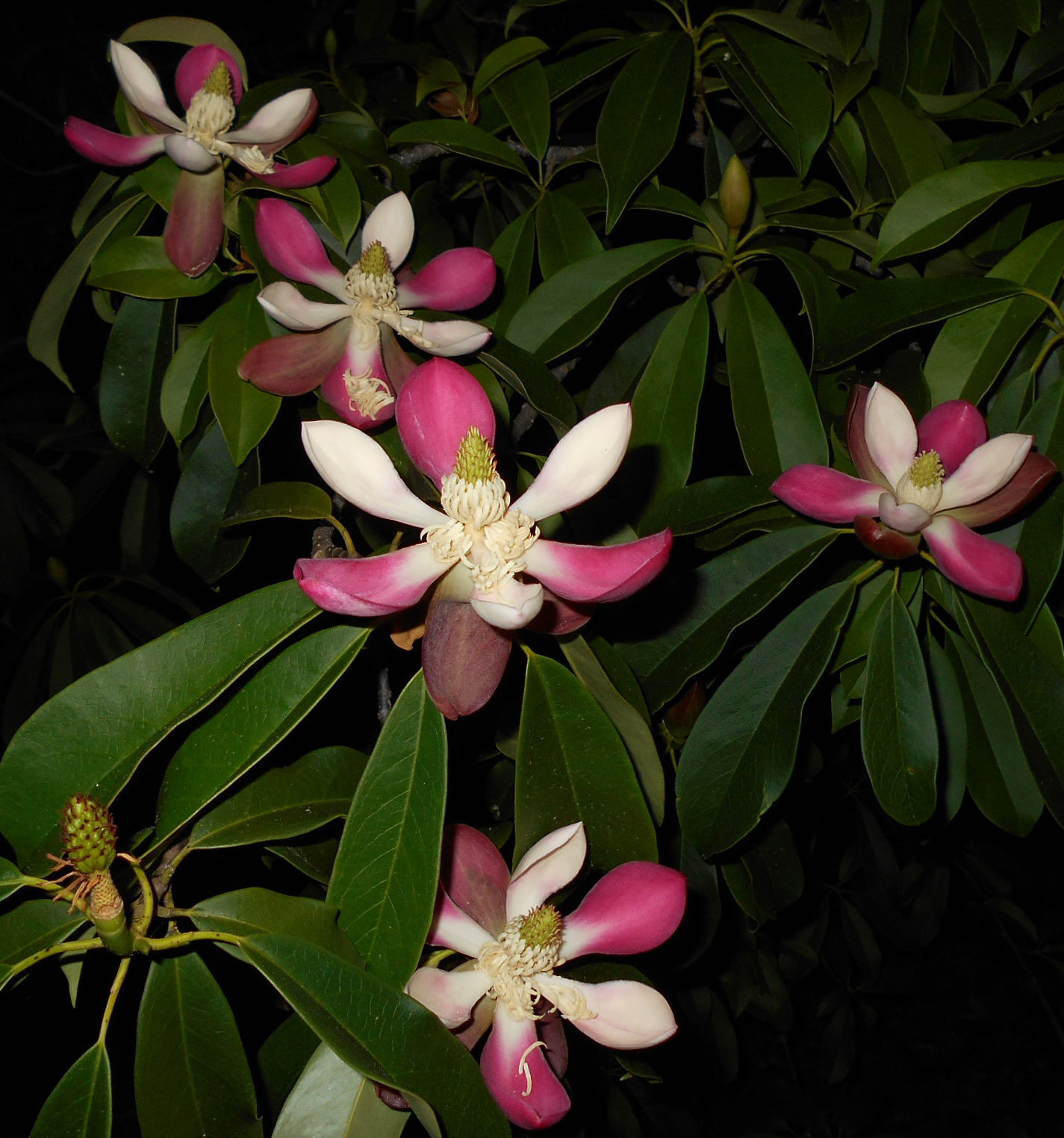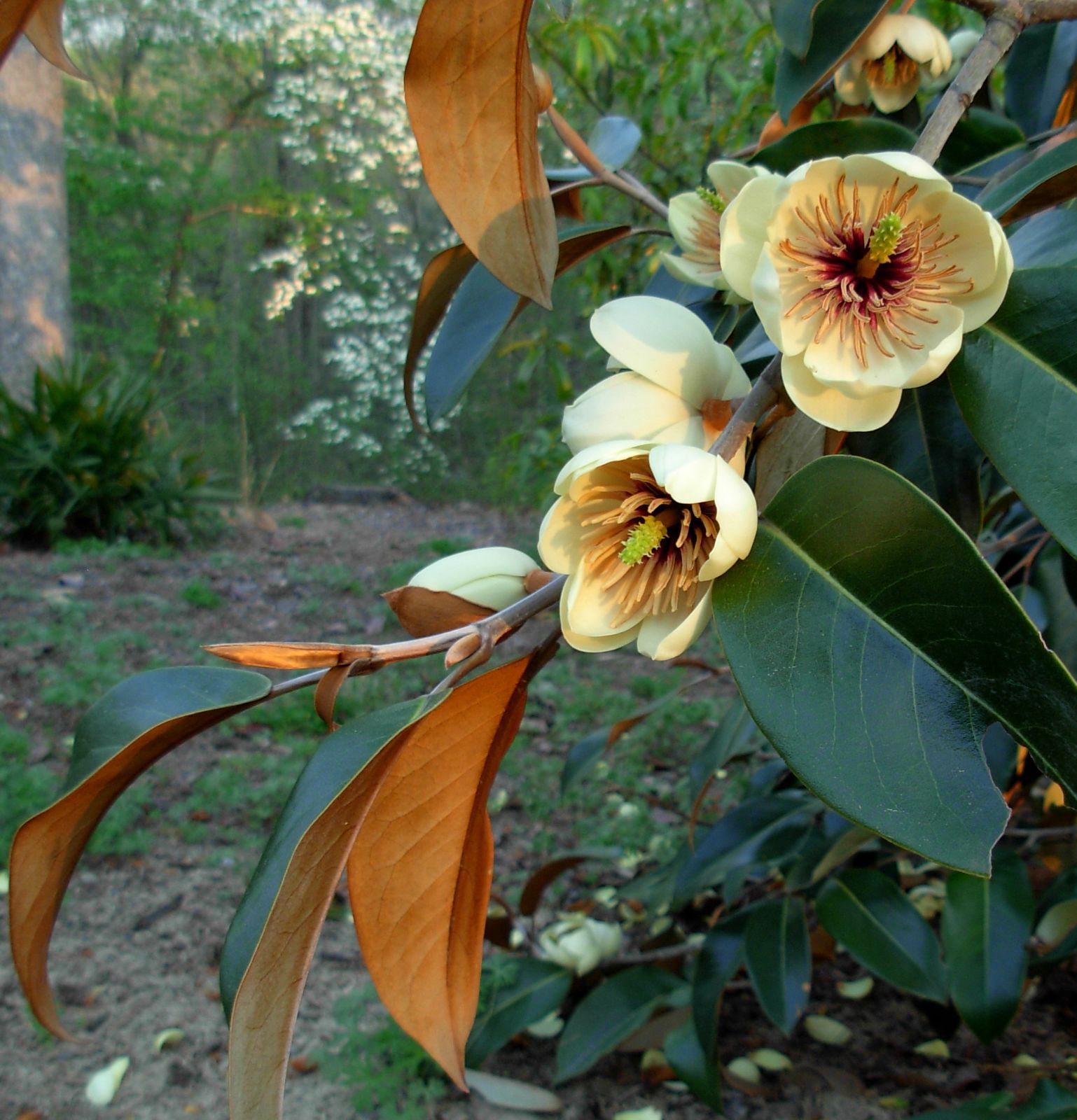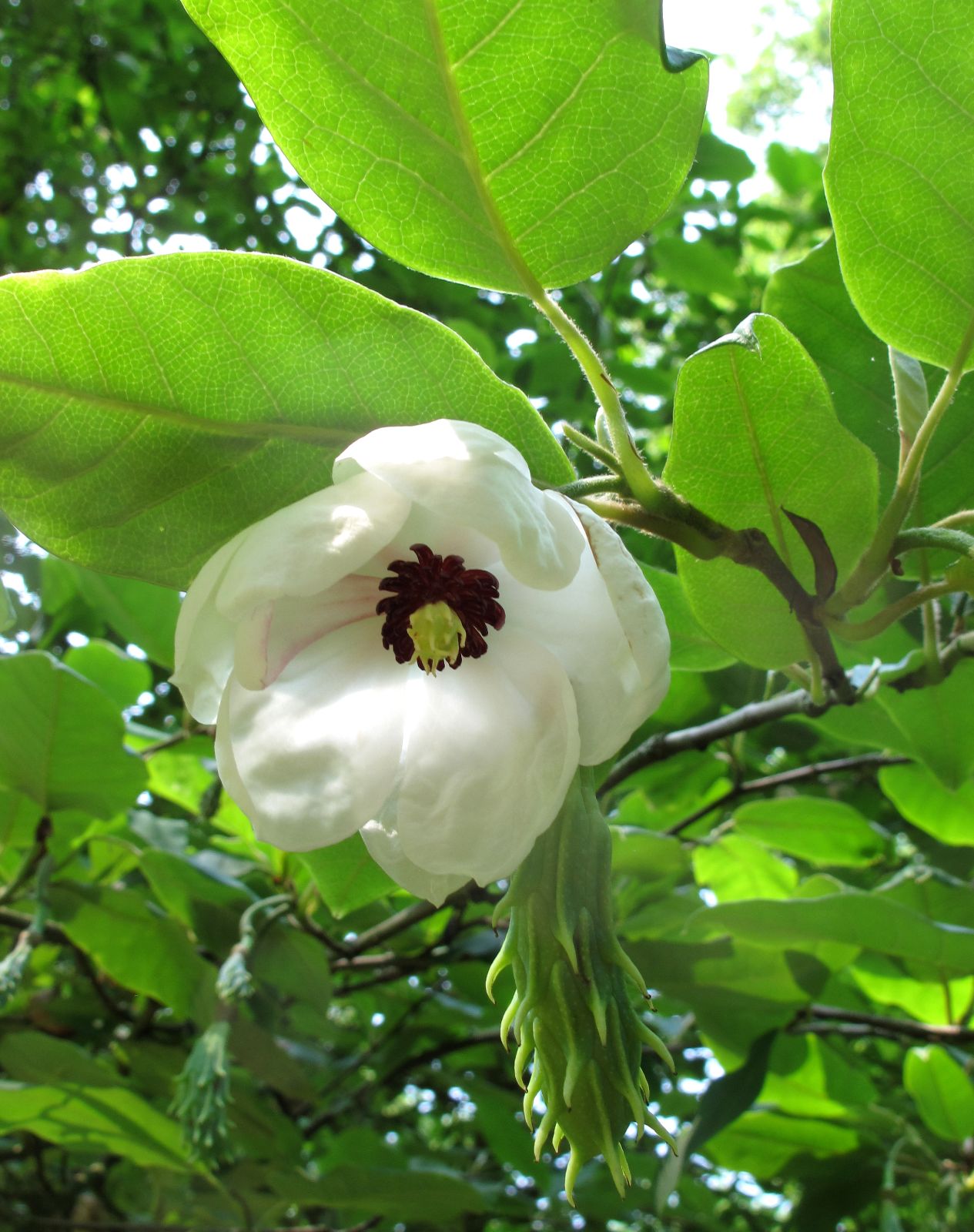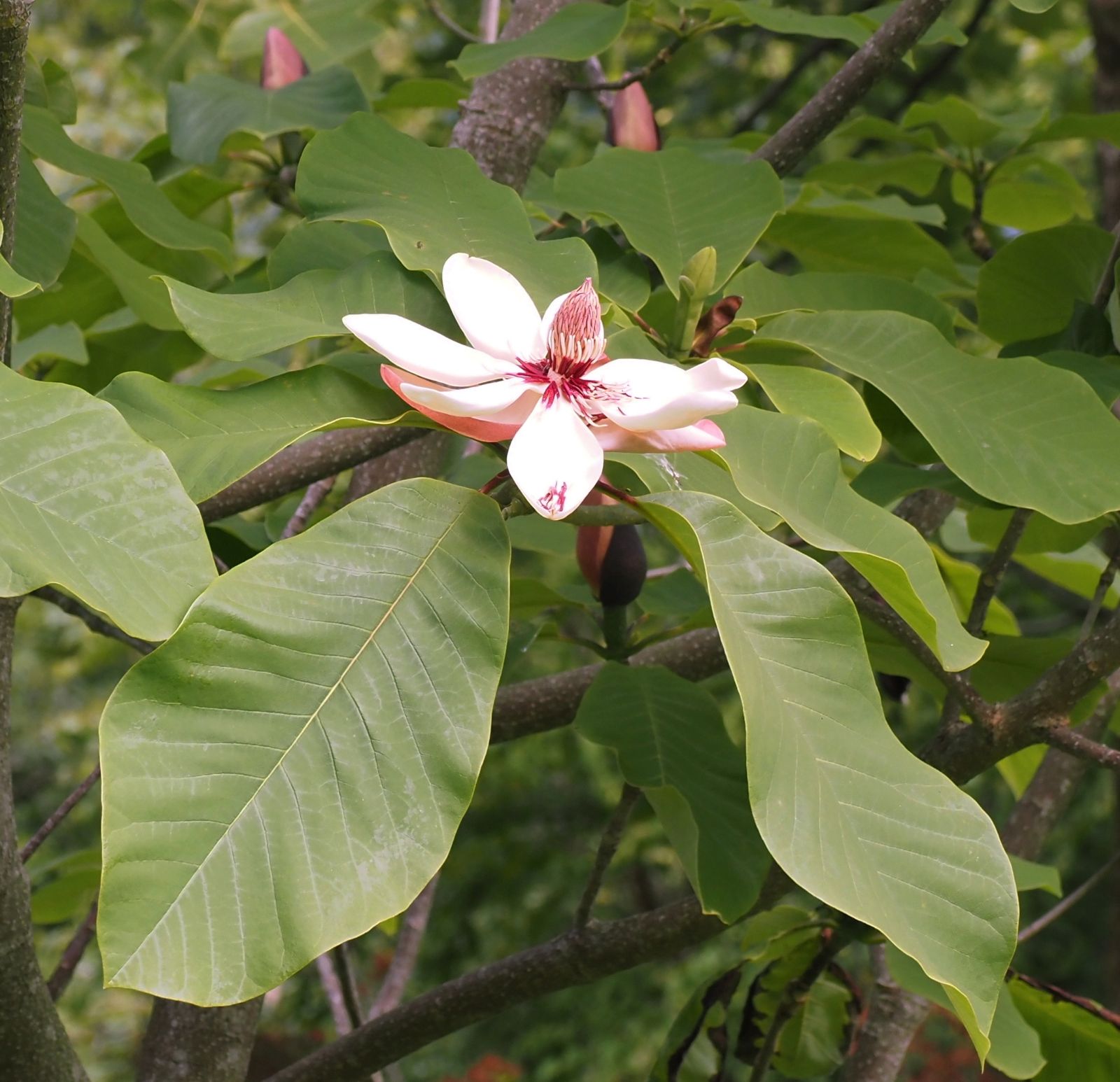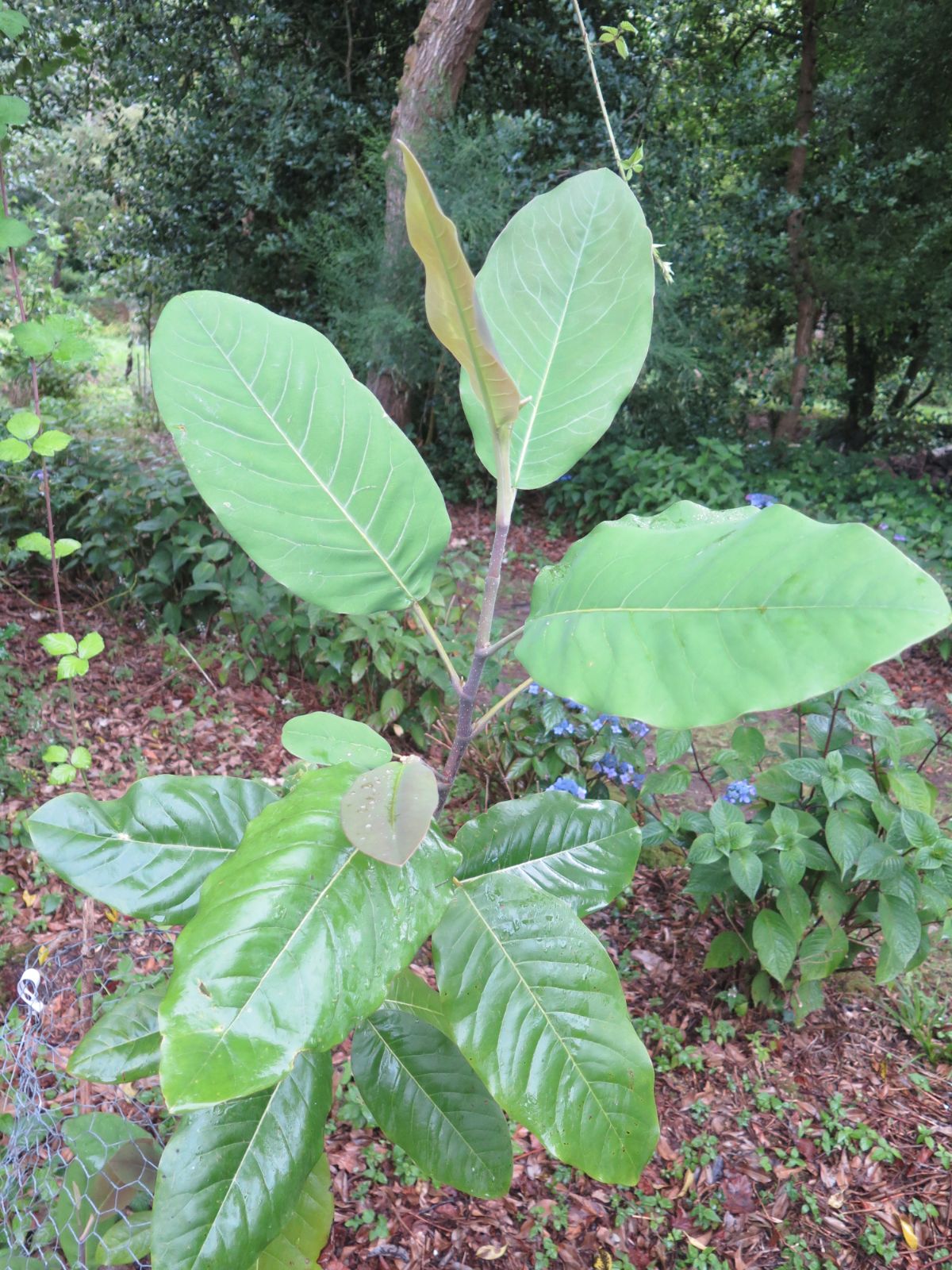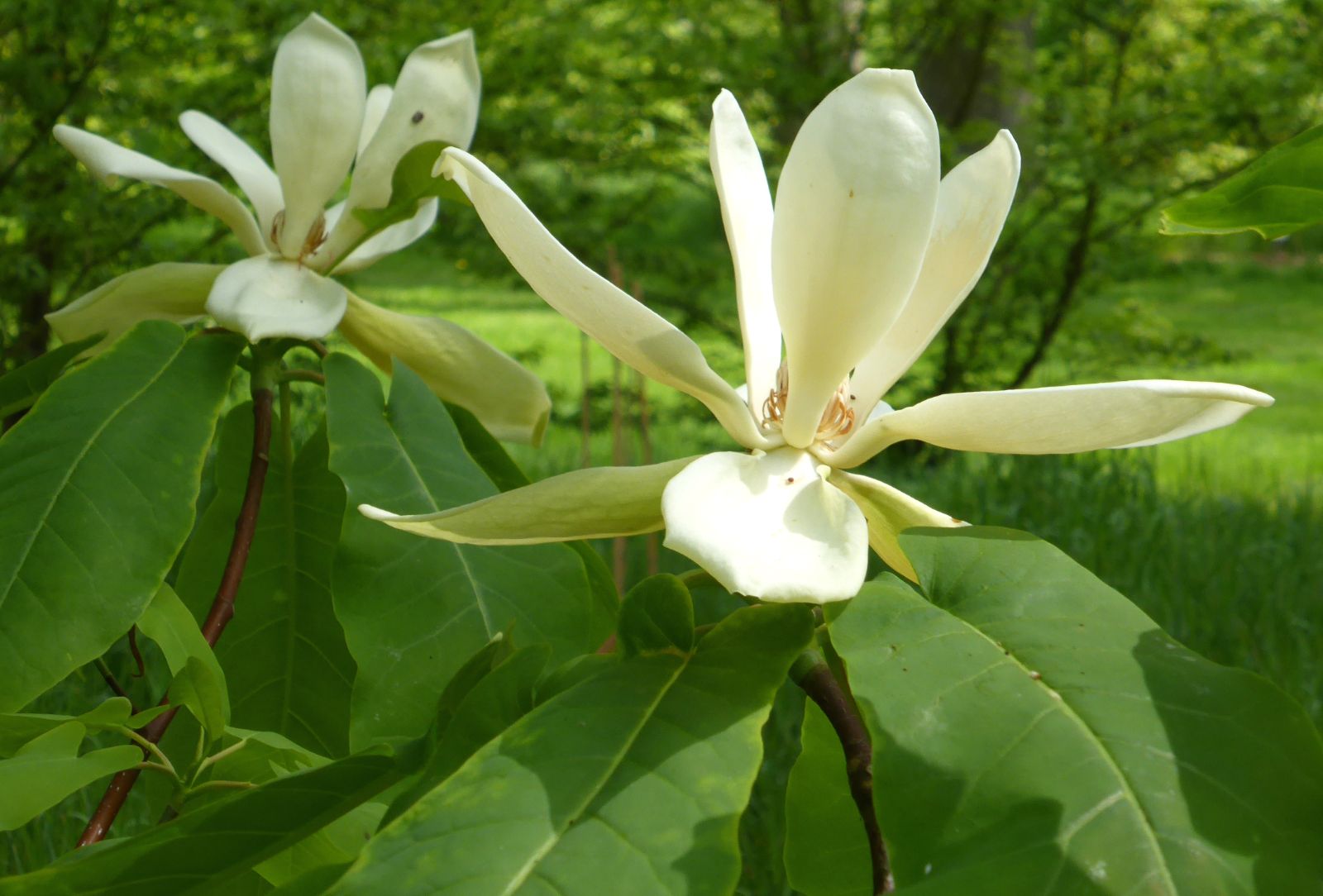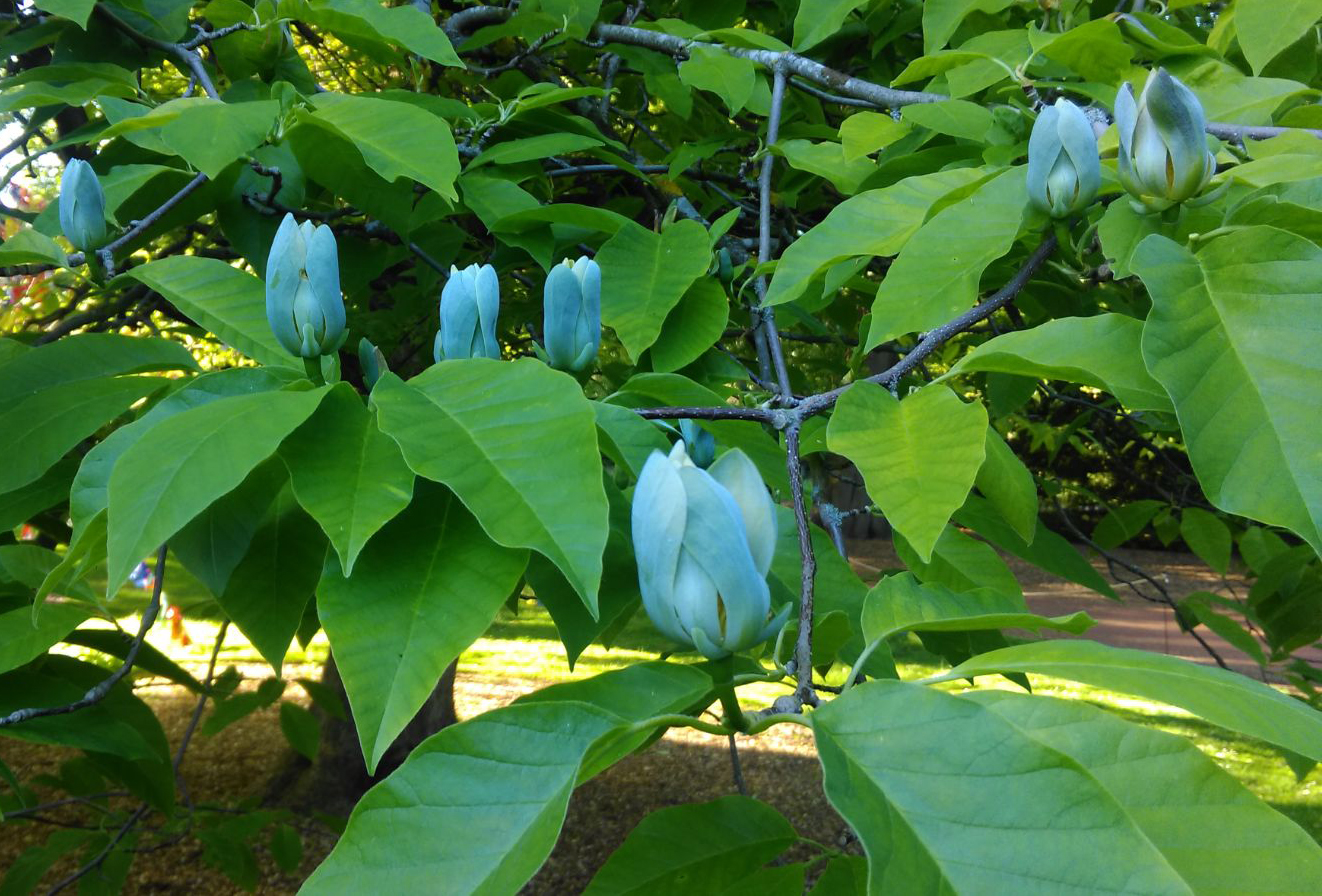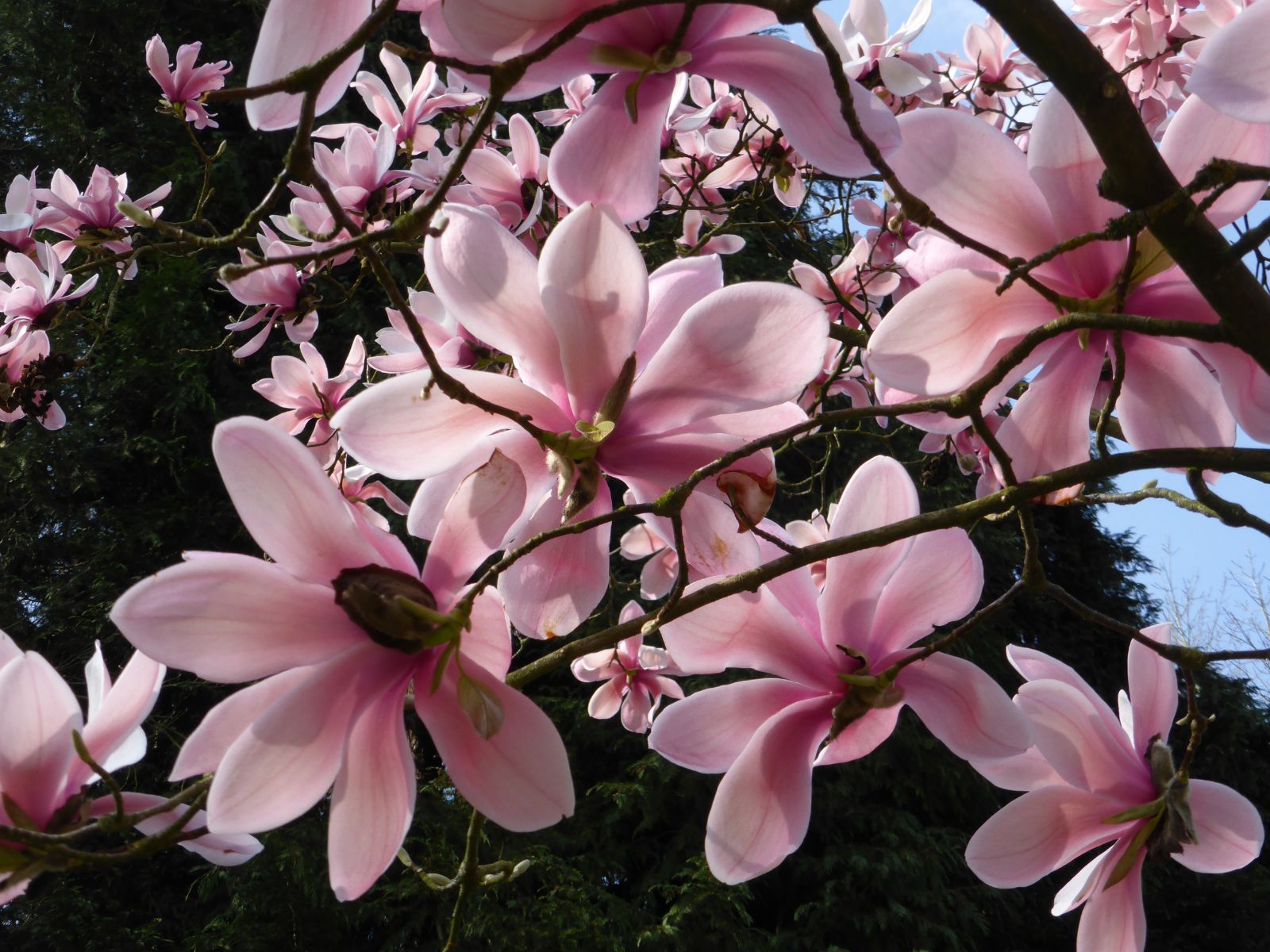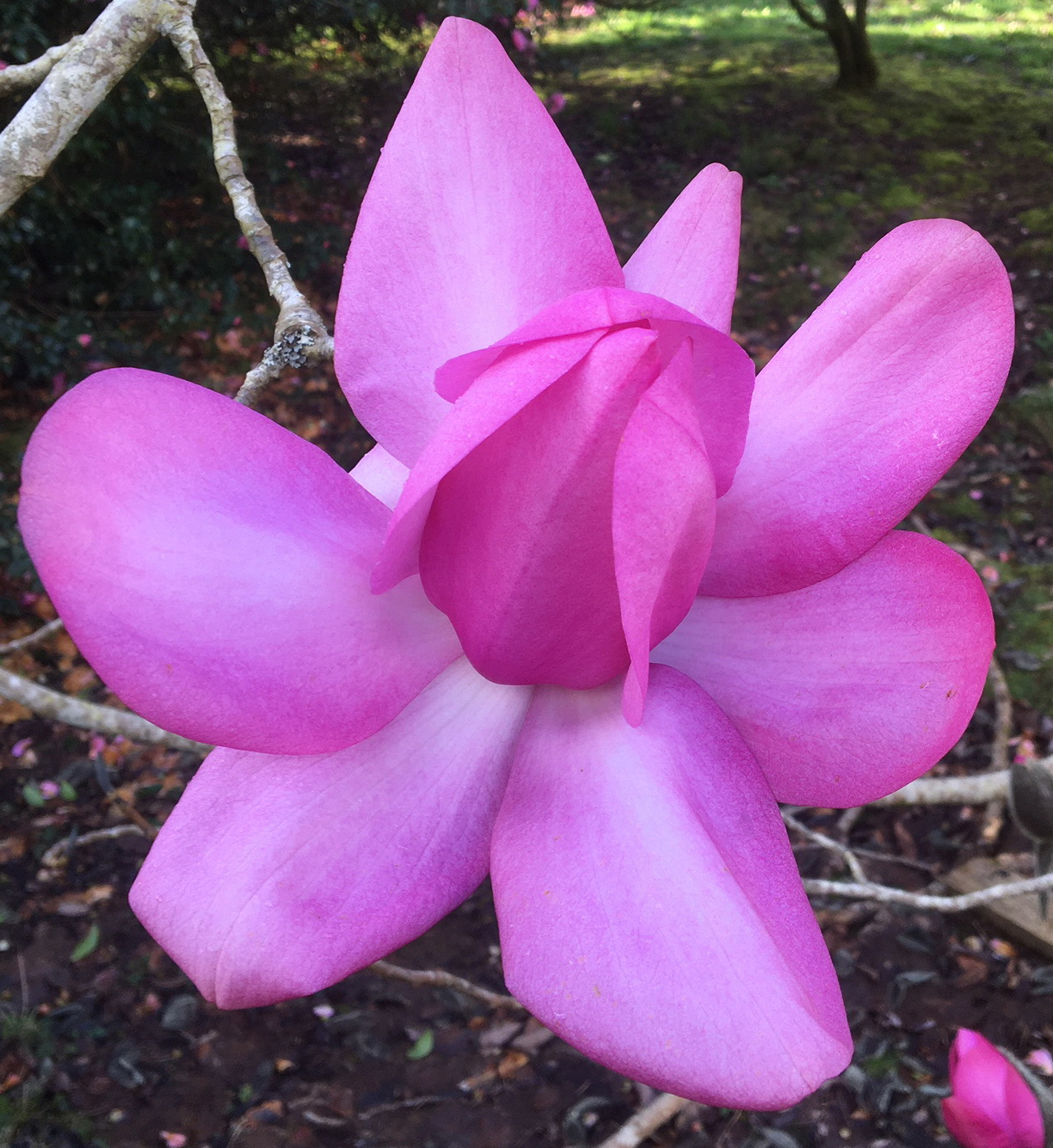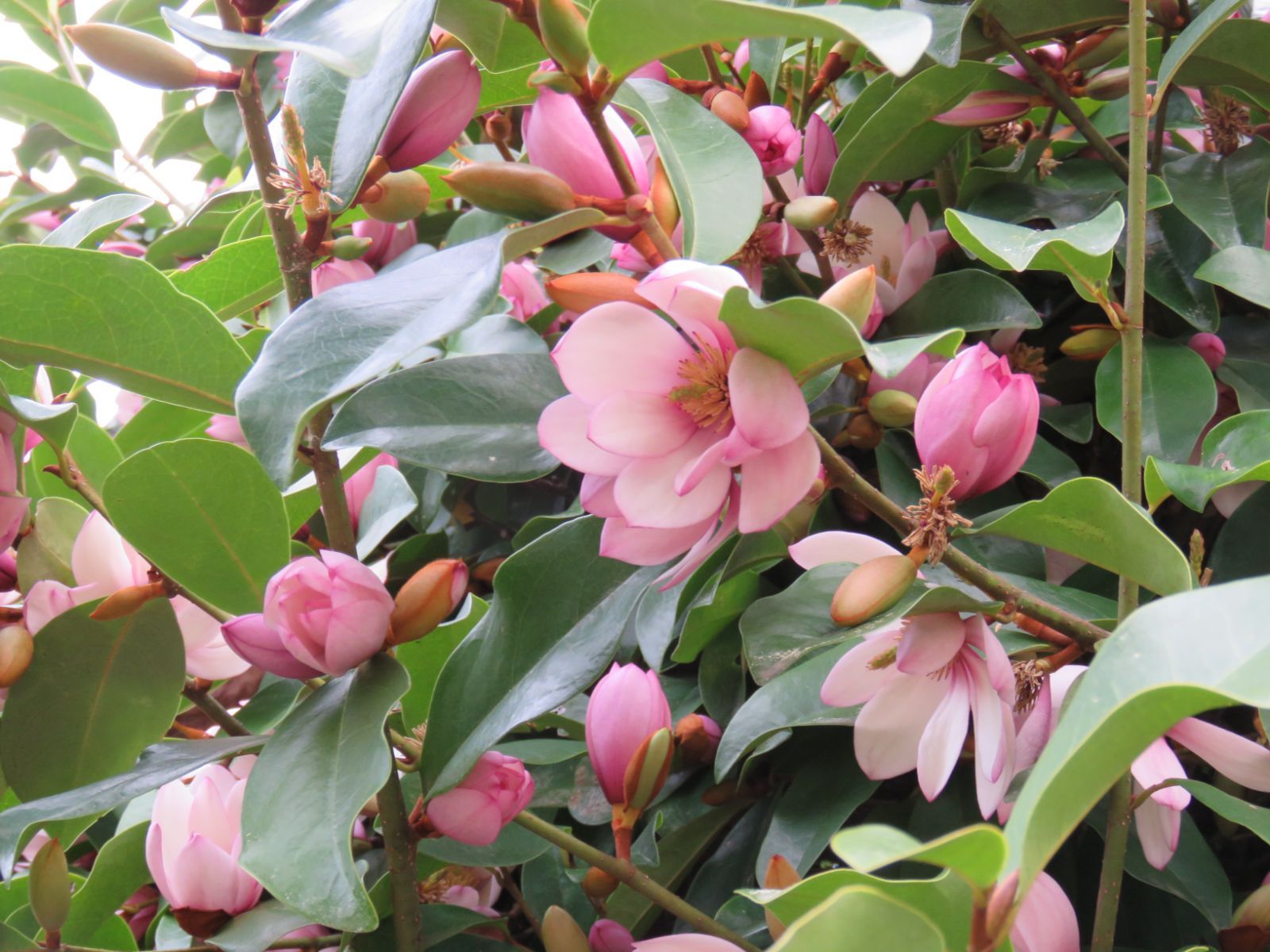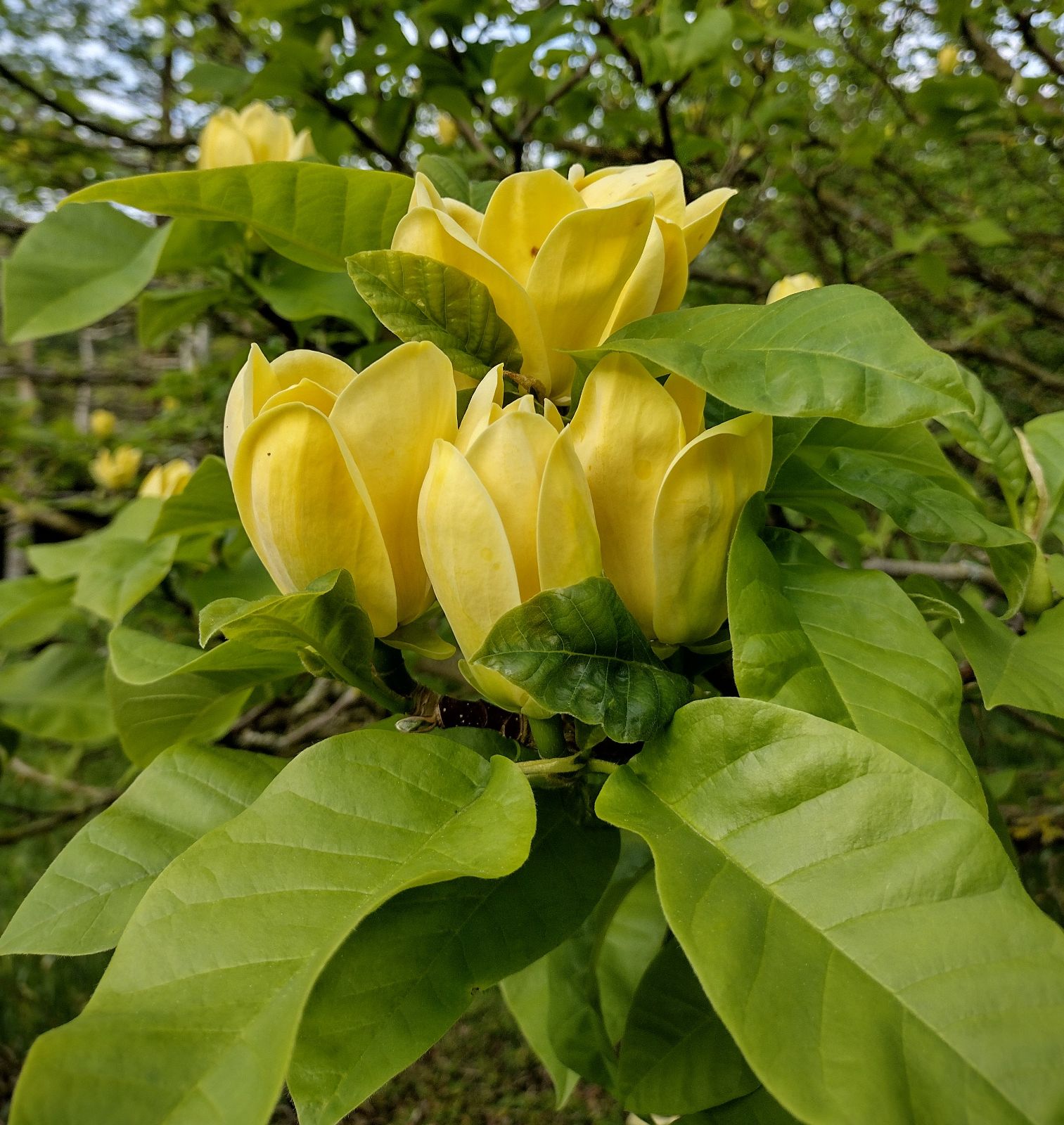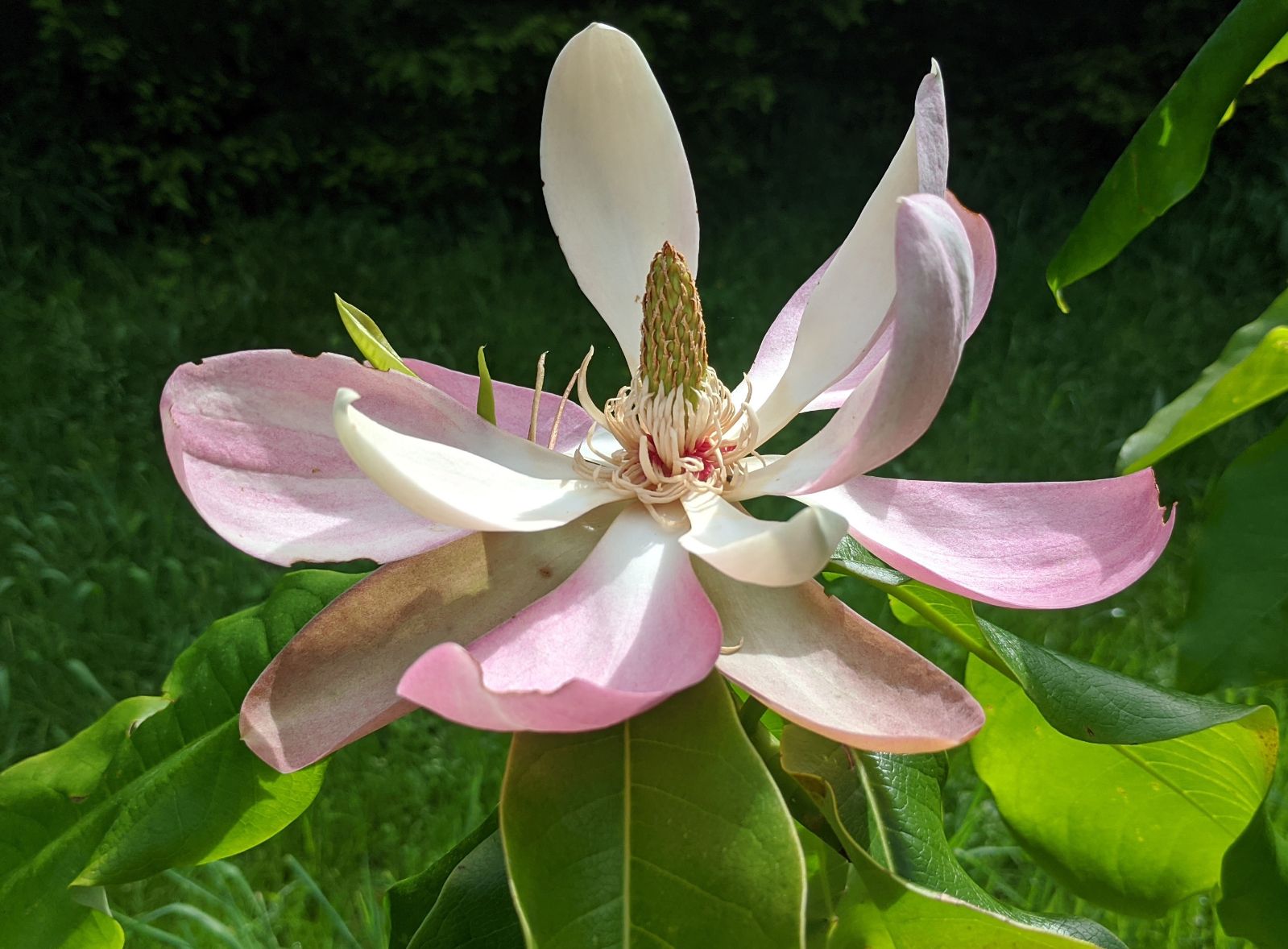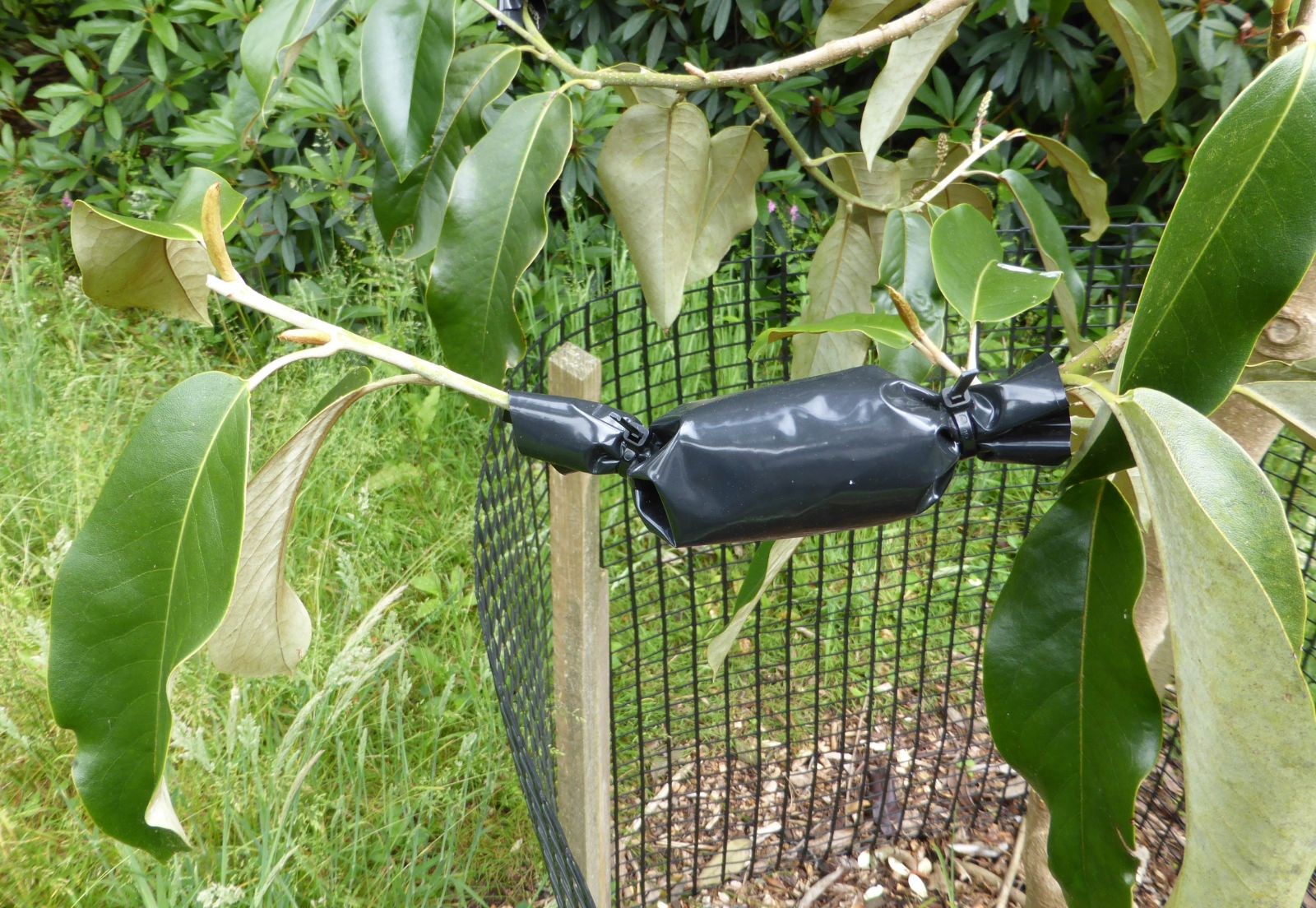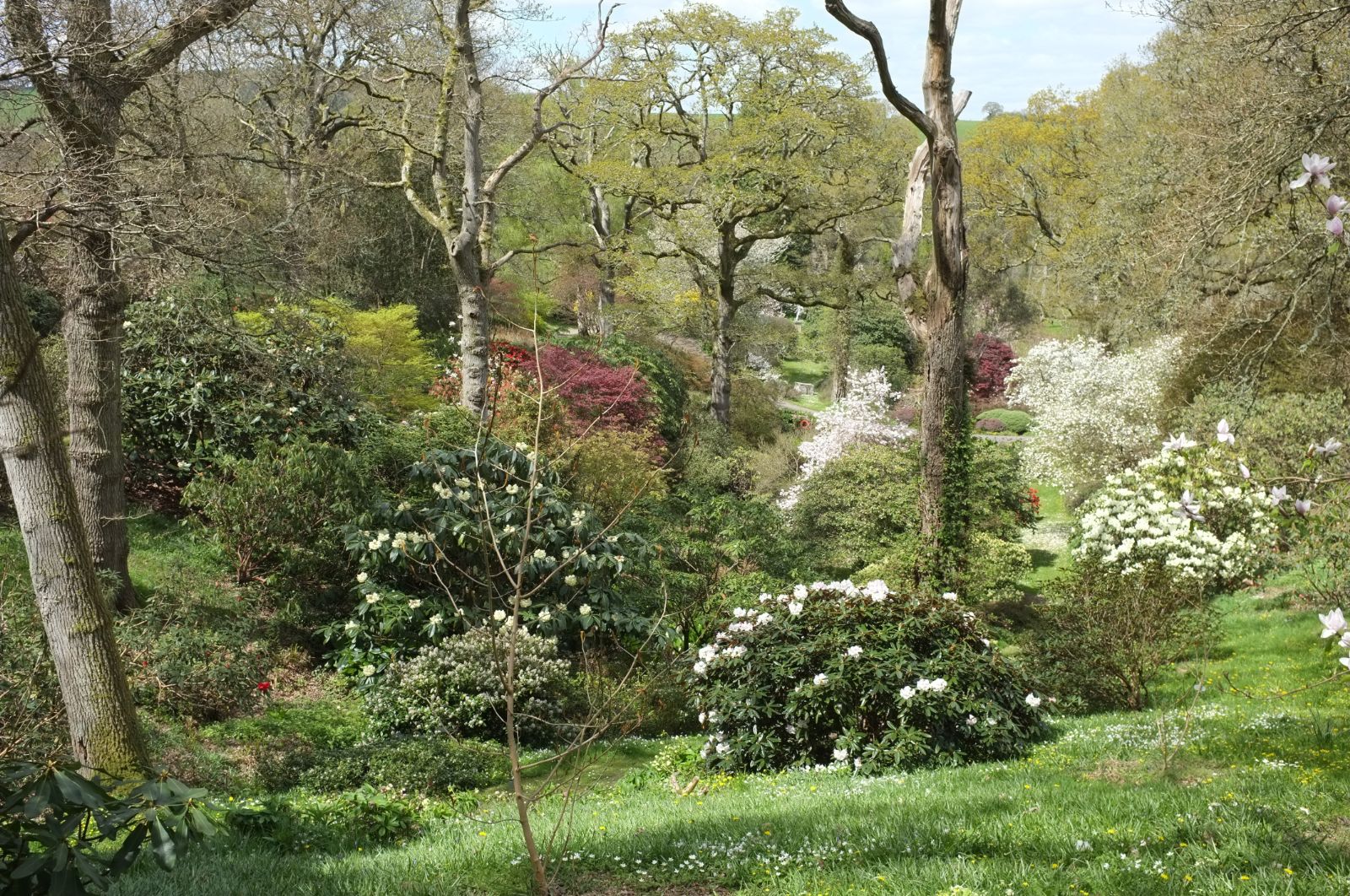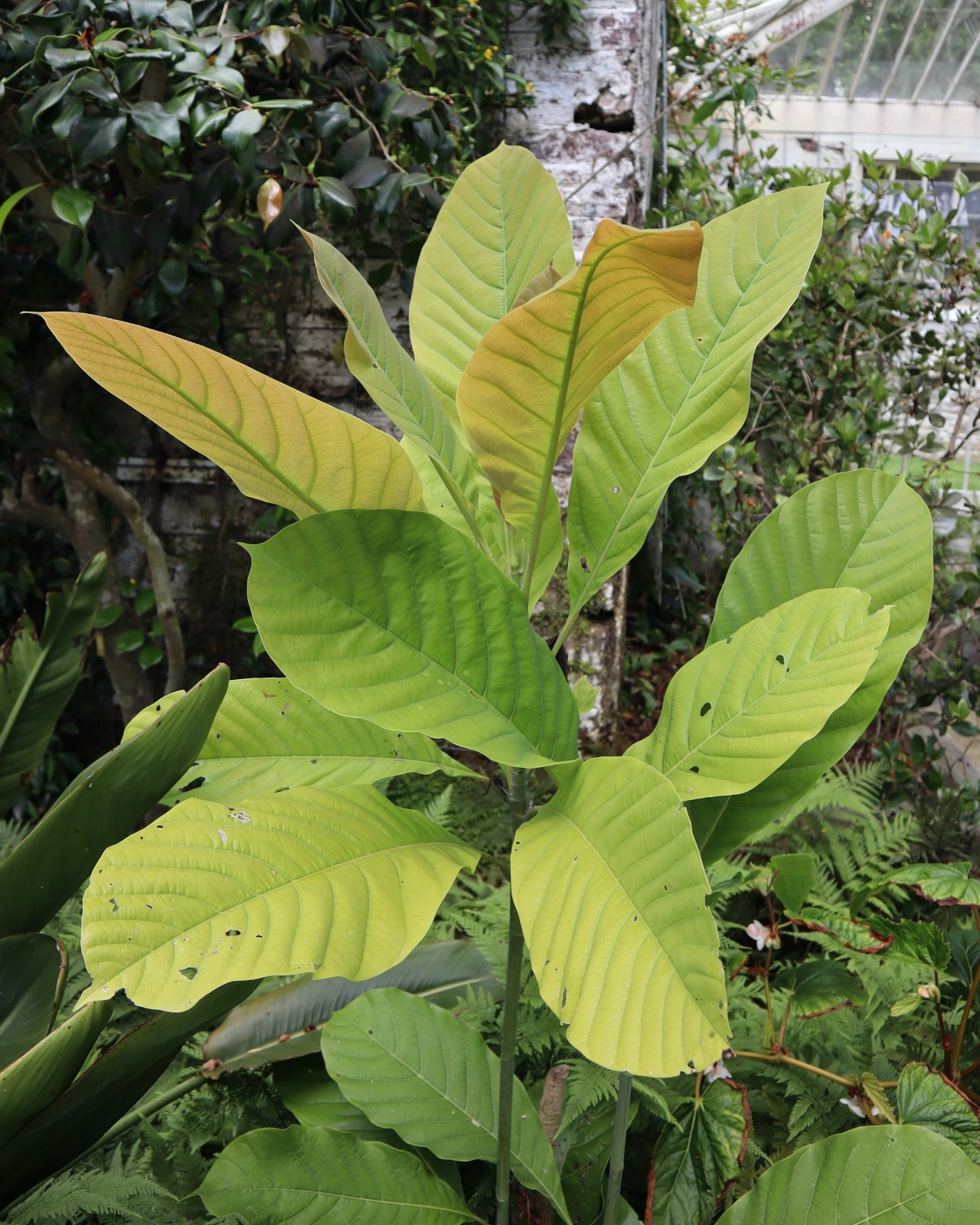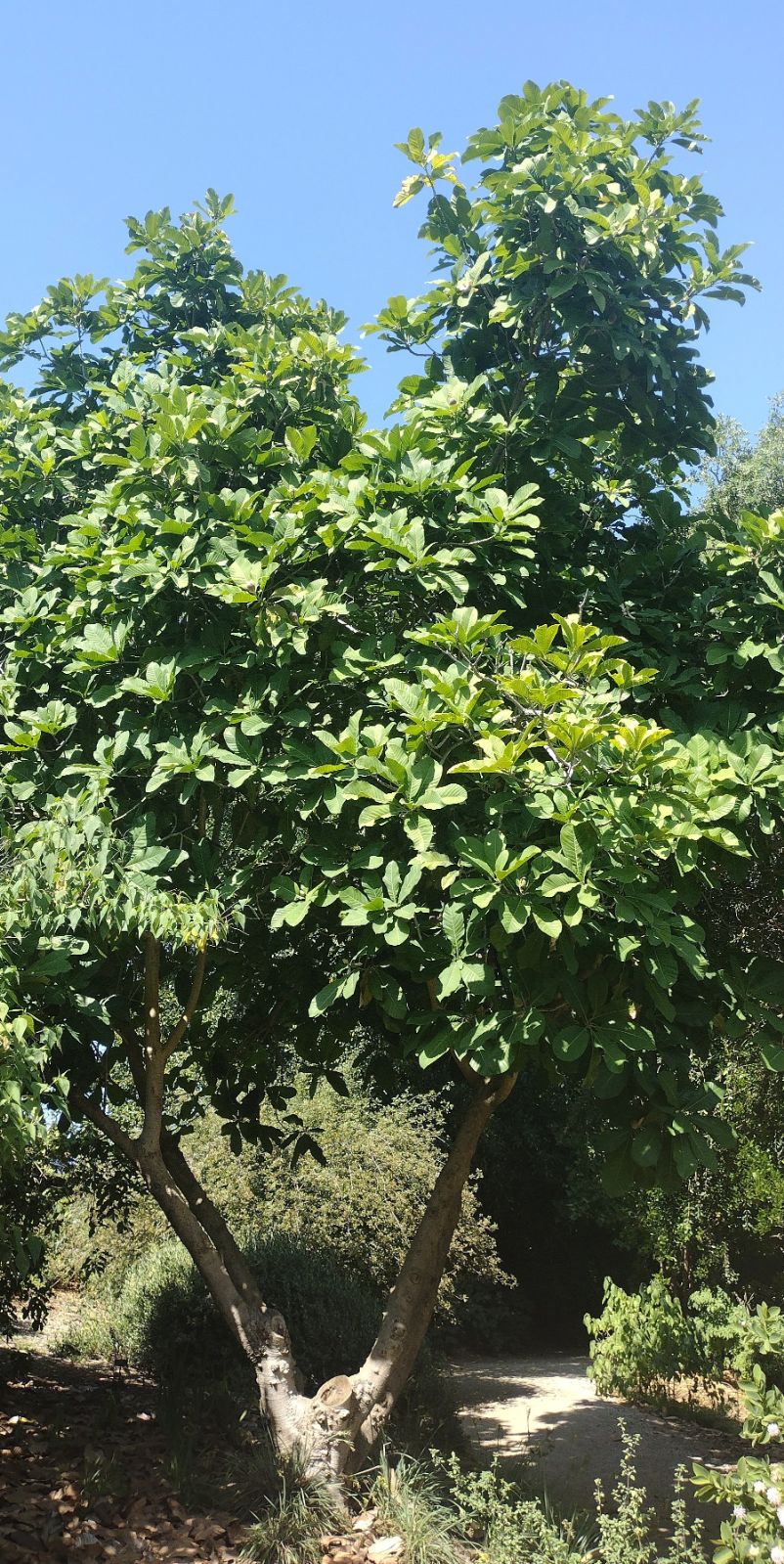Magnolia
Sponsor
Kindly sponsored by
The Roy Overland Charitable Trust

Credits
Julian Sutton (2022)
Recommended citation
Sutton, J. (2022), 'Magnolia' from the website Trees and Shrubs Online (treesandshrubsonline.
Family
- Magnoliaceae
Common Names
- Magnolias
- Manglietias
- Michelias
- Yulanias
- Oyamas
Synonyms
- Alcimandra Dandy
- Aromadendron Blume
- Dugandiodendron Lozano
- Elmerrillia Dandy
- Houpoëa N.H. Xia & C.Y. Wu
- Kmeria Dandy
- Manglietia Blume
- Manglietiastrum Y.W. Law
- Michelia L.
- Pachylarnax Dandy
- Parakmeria Hu & W.C. Cheng
- Paramanglietia Hu & W.C. Cheng
- Paramichelia Hu
- Talauma Juss.
- Tsoongiodendron Chun
- Woonyoungia Y.W. Law
- Yulania Spach
Species in genus
- Magnolia acuminata
- Magnolia × alba
- Magnolia amabilis
- Magnolia amoena
- Magnolia aromatica
- Magnolia biondii
- Magnolia × brooklynensis
- Magnolia campbellii
- Magnolia cathcartii
- Magnolia cavaleriei
- Magnolia caveana
- Magnolia champaca
- Magnolia changhungtana
- Magnolia chapensis
- Magnolia compressa
- Magnolia conifera
- Magnolia Cultivars A
- Magnolia Cultivars B
- Magnolia Cultivars C
- Magnolia Cultivars D
- Magnolia Cultivars E
- Magnolia Cultivars F
- Magnolia Cultivars G
- Magnolia Cultivars H–I
- Magnolia Cultivars J
- Magnolia Cultivars K
- Magnolia Cultivars L
- Magnolia Cultivars M
- Magnolia Cultivars N–O
- Magnolia Cultivars P
- Magnolia Cultivars Q–R
- Magnolia Cultivars S
- Magnolia Cultivars T
- Magnolia Cultivars U–V
- Magnolia Cultivars W–Z
- Magnolia cylindrica
- Magnolia dandyi
- Magnolia dawsoniana
- Magnolia de Vos and Kosar hybrids
- Magnolia decidua
- Magnolia delavayi
- Magnolia denudata
- Magnolia doltsopa
- Magnolia duclouxii
- Magnolia ernestii
- Magnolia figo
- Magnolia floribunda
- Magnolia × foggii
- Magnolia fordiana
- Magnolia foveolata
- Magnolia fraseri
- Magnolia fulva
- Magnolia globosa
- Magnolia × gotoburgensis
- Magnolia grandiflora
- Magnolia grandis
- Magnolia Gresham hybrids
- Magnolia guangdongensis
- Magnolia hookeri
- Magnolia insignis
- Magnolia Jury hybrids
- Magnolia × kewensis
- Magnolia kobus
- Magnolia kwangtungensis
- Magnolia laevifolia
- Magnolia lanuginosa
- Magnolia leveilleana
- Magnolia liliiflora
- Magnolia × loebneri
- Magnolia lotungensis
- Magnolia macclurei
- Magnolia macrophylla
- Magnolia martini
- Magnolia maudiae
- Magnolia nitida
- Magnolia obovata
- Magnolia officinalis
- Magnolia opipara
- Magnolia × proctoriana
- Magnolia × pruhoniciana
- Magnolia rostrata
- Magnolia salicifolia
- Magnolia sapaensis
- Magnolia sargentiana
- Magnolia sieboldii
- Magnolia sinensis
- Magnolia sinica
- Magnolia sinostellata
- Magnolia × soulangeana
- Magnolia sprengeri
- Magnolia stellata
- Magnolia tamaulipana
- Magnolia × thomsoniana
- Magnolia tripetala
- Magnolia × veitchii
- Magnolia virginiana
- Magnolia × wieseneri
- Magnolia wilsonii
- Magnolia xinganensis
- Magnolia yunnanensis
- Magnolia yuyuanensis
- Magnolia zenii
A genus of perhaps 330 living species indigenous to Asia east and south of the Himalayas, and the Americas, heavily concentrated in warm temperate to subtropical areas.
Evergreen, deciduous or semi-evergreen small to medium trees or shrubs, with alternate, entire, pinninerved leaves. Stipules present and initially enclosing the terminal bud, later falling to leave a scar whose length is an important diagnostic feature in some groups; the stipules are sometimes called ‘perules’ when covering an overwintering flower bud, and are often attractively hairy. Flowers solitary, hermaphrodite or rarely unisexual, terminal on long shoots or on short axillary shoots (brachyblasts), with floral parts arranged along an elongated receptacle. Perianth comprising several whorls of tepals, most or all petaloid, the outermost whorl sometimes smaller and sepaloid; stamens numerous, spirally arranged and flattened, anther poorly differentiated from filament. Female part of the flower (gynoecium) sessile or stalked; carpels numerous (rarely solitary) and spirally arranged; they may be free (apocarpous) or fused (syncarpous). Fruiting carpels (follicles) usually dehiscent, each producing one or more large seeds. Carpels may be fleshy, and can fuse together to form a berry-like fruit (the term ‘fruit’ will be used here to refer to the aggregate of follicles, whether fused together or not). After dehiscence, follicles often become woody and persist on the tree. Seeds each have a red or orange outer layer, the sarcotesta (sometimes referred to as an aril in older literature; but a sarcotesta develops from the outer integument, an aril from the funicle – Silveira, Dornelas & Martinelli 2016). Seeds are sometimes pendulous, hanging out from the carpel on a slender thread. (Chen & Nooteboom 1993; Grimshaw & Bayton 2009).
Acknowledgements
This monumental entry for Magnolia on IDS Trees and Shrubs Online has been made possible through the extremely generous support of the Roy Overland Charitable Trust, which is gratefully acknowledged.
The text has been prepared by Dr Julian Sutton, a heroic effort made possible by generous assistance from many others. A core foundation was the text of Magnolias, A Gardener’s Guide (Gardiner 2000) kindly supplied by Jim Gardiner, who has also provided much supplementary information and images along the way. The Magnolia entry from New Trees (Grimshaw & Bayton 2009) was also foundational, particularly for its information on the Asian evergreen species. Richard Figlar wrote new text for six recently introduced, unfamiliar species, and has commented on the whole text. Philippe de Spoelberch has given freely of his time, information and images: “too many images by Philippe de Spoelberch” he says, but we beg to disagree. As well as commenting on parts of the text, Charles Williams has been extremely generous in extracting many images from the Caerhays Estate archive, with the aid of his staff, and we are very grateful for this immense boost to the pictorial record of the genus presented here. Others who have helped with information, comments and suggestions include Andrew Bunting, Koen Camelbeke, Glyn Church, Maurice Foster, Tom Hudson, Antonia Johnson, Abbie & Mark Jury, Nick Macer and Matt Lobdell. We thank them all for their contribution to the knowledge of Magnolia worldwide and their help in creating this landmark document.
Images have been supplied by many people, all credited in the captions; we are very grateful to them all for enabling the presentation of such a well-illustrated account of this magnificent genus.
John Grimshaw, Editor-in-Chief, May 2022
Introduction
By any measure, Magnolia is one of the most important woody plant genera of temperate gardens. The number and diversity of species grown, the constellation of hybrid cultivars, the impact made by flowering specimens – all these are exceptional. This is particularly surprising given that the majority of species in this large genus, with its bewildering diversity in subtropical Asia and warm parts of the Americas, are too tender for most or all of our area (the temperate parts of North America, Europe, Asia and Australasia). Magnolia encompasses canopy trees, understorey species and unambiguously shrubby plants; some are deciduous, some evergreen or semi-evergreen. Species still familiar to some as Michelia or Manglietia are included here, but are easily recognized as magnolias by their distinctive shared flower structure.
Magnolia in the Magnoliaceae
We follow most (but not all) contemporary opinion in accepting just two genera in the family Magnoliaceae, Magnolia itself and Liriodendron, a small genus of deciduous trees. Magnolia differs from Liriodendron in its almost always unlobed leaves (very rarely 2-lobed at the tips) (versus variously but decisively lobed), and in its fruit structure. In Liriodendron each carpel develops as a 2-seeded samara; these are packed together into a cone-like structure, but fall away at maturity to leave the inflorescence axis on the tree. In Magnolia, each carpel within the cone-like fruit is a follicle which remains attached to the axis but dehisces, releasing the more or less fleshy seeds; each carpel has 2–8(–many) seeds, depending on its section. Fruits are often distorted due to seed abortion.
This has not always been the dominant view. Through the middle decades of the 20th century, most botanists and horticulturalists followed Dandy (1927) in treating Subfamily Magnolioideae (i.e. everything we include here in Magnolia) as nine (later 11) separate genera, Magnolia, Manglietia, Michelia, Talauma and several minor genera; fruit characters were considered especially important. Further minor genera were added by Liu (see Liu et al. 2004, perhaps this treatment’s last use in a major reference book).
However, the realization that some shared fruit characters were probably the result of convergent evolution rather than shared ancestry was already leading to a reduction in the number of genera recognized by other workers, Nooteboom (1985) sinking Talauma into Magnolia, and some minor genera into Magnolia and Michelia. Further, early molecular phylogenetic work (notably Kim et al. 2001; Azuma et al. 2001) showed that both Manglietia and Michelia as well as some minor genera were nested among the sections of Magnolia, making Magnolia ‘pretty wildly paraphyletic’ (Stevens 2022).
Figlar & Nooteboom (2004) resolved the issue by proposing a single genus Magnolia in Subfamily Magnolioideae, with 13 major branches of the phylogenetic tree as sections or subsections. The cost of this approach in name changes was relatively light. Apart from changes to generic names (all Michelia spp. become Magnolia spp., etc) very few changes to specific epithets were needed. Two examples of the latter are Michelia wilsonii and M. yunnanensis becoming Magnolia ernestii and M. laevifolia, the original epithets having already been used in Magnolia for other plants. European and North American botanists, with horticulture following, have almost unanimously taken up this one-genus approach, as we do here.
A valid alternative resolution is to raise each of these major branches to generic status, although some of these are difficult to define on morphological grounds, and it would lead to considerably more changes to familiar names than does the one-genus approach. The concept of Yulania × soulangeana would probably appeal to few gardeners! Significantly, an increasing number of hybrid cultivars would then be bigeneric, leading to a proliferation of cumbersome nothogeneric names. Many Chinese workers have taken this second route. The divergence in practice is exemplified by the Flora of China treatment (Xia, Liu & Nooteboom 2008), the first two authors favouring the many-genus approach around which their account is structured, with Nooteboom’s opposite view requiring an additional list of Magnolia names for all included taxa. Even today, when searching for recent research papers on a Magnolia species, it is wise to repeat the search using its alternative generic name.
An Ancient Group?
The idea that magnolias are a particularly ancient group of flowering plants has a popular hold, but this is to overstate the case. Certainly, molecular evidence (summarized in Stevens 2022) places the Magnoliaceae, along with families including Lauraceae and Piperaceae, in a clade (Magnoliales) which branched before the divergence of the monocotyledons and eudicotyledons. Waterlilies (Nymphaeaceae) and the tropical shrub Amborella diverged earlier. The earliest fossils of flowers from 100–120 MYA include recognizable members of the Magnoliales (Doyle 2015), but Magnolia itself probably dates only from the Tertiary. Estimates of when it emerged based on molecular data include 55 and 45 MYA (Nie et al. 2008; Veltjen et al. 2022).
An important, ongoing question is whether the ancestral flowering plants had hermaphrodite flowers with perianth segments arranged in whorls but not differentiated into petals and sepals (as in Magnolia) or unisexual flowers organized spirally (as in Amborella). A significant recent modelling study favours the Magnolia-like pattern (Sauquet et al. 2017).
Regardless of origins, magnolias were an important part of the warm-temperate forest vegetation which covered much of Asia, Europe and North America through the Tertiary, and are commonly found as fossils from this period. Their restricted present-day range – they are completely absent from Europe, West Asia and western North America – follows the climatic upheavals of the Pleistocene (Azuma et al. 2001 and references therein).
Classification: a Route Map to Magnolia Diversity
In a genus this big, anyone trying to explore its diversity should find helpful a basic understanding of how taxonomists have subdivided. Most who favour the ‘one genus’ approach outlined above have divided Magnolia into 3 subgenera and 12 sections, with some sections further divided into subsections, following Figlar & Nooteboom (2004) and (more accessibly) Figlar (2012). However, this is certainly not the last word on the subject. A revised classification which recognizes 15 sections, with no subgenera or subsections, has recently been proposed (Wang et al. 2020), based on analysis of whole plastid genome sequences. This overcomes a taxonomic problem with the previous classification, Subgenus Magnolia having been found not to be monophyletic. More importantly for our purposes it is a simple, easily understood, single-tier classification. The major groupings of species relevant to gardens in our area remain intact, usually with the same names if not always at the same taxonomic level. The study’s authors include Chinese and American workers (including American authority Richard Figlar), giving some hope that it might come to be accepted internationally. We use this classification here, outlining the sections below. A table equating these to the more established classification of Figlar & Nooteboom (2004) follows. Numbers of species listed are approximate, primarily based on the recent overview of Wang et al. (2020). As ever, research continues and taxonomic opinions vary. Species are being described especially rapidly in Central America and Mexico, part of a trend towards recognition of local, allopatric species in diverse woody plant genera in these rich floras.
Some sectional names have become familiar in either the old generic sense, or as anglicized ‘common names’ (“michelia/s,” “manglietia,” “oyama,” “yulania”), as indeed the generic name has become the vernacular “magnolia/s” (covering all sections). They can be useful informal shorthands for discussing plants, and we sometimes use them here in this way.
Section Gwillimia (about 28 species, 1 described here)
Leaves evergreen; leaves folded in half in bud (conduplicate vernation – a feature of all other sections except Gynopodium); branches usually start growth on initiation, without first forming a bud (syllepsis); stipular scar (75–)100% length of petiole; flowers terminal, 2 ovules per carpel, stamens fall during male phase (caducous). A large group of mostly tender species distributed from Nepal to SE Asia by way of Myanmar and S China. Only one species, M. delavayi, is known to grow outdoors in our area. M. hodgsonii (Hook.f. & Thomson) H.Keng (a showy, large-flowered tree from lower altitudes, ranging from Bhutan to Thailand) is sometimes seen as a glasshouse plant in our area, and more widely grown in subtropical and Mediterranean areas. It is illustrated below. M. coco (Lour.) DC, from SE China, is widely grown in warmer parts of the world.
Section Gynopodium (8 species, 4 described here)
Asiatic evergreens, some hardy in mild parts of our area; leaves not folded in bud (open vernation), unlike all other sections; branching sylleptic; plant entirely glabrous; no stipular scar; flowers terminal, 2–8 carpels per ovule, gynoecium stalked in some species, stamens remain attached throughout male phase of flower (persistent); some species have both male and hermaphrodite flowers. Some are still sometimes seen in collections labelled as Parakmeria spp. We describe MM. lotungensis, nitida, sinica and yunnanensis. Of the remaining species M. kachirachirai (Kanehira & Yamamoto) Dandy (Taiwan, differing from M. nitida in its narrower, thinner textured leaves) and M. omeiensis (W.C.Cheng) Dandy (Sichuan, very like M. lotungensis – Xia, Liu & Nooteboom 2008) seem like plants which might one day appear in cultivation.
Section Kmeria (3 species, none described here)
Asiatic evergreens with sylleptic branching; stipular scar (90–)100% length of petiole; flowers terminal, 2 ovules per carpel, stamens caducous. These are the only truly dioecious magnolias, with unisexual flowers on seperate male and female trees. One southern Chinese species, M. kwangsiensis Figlar & Noot., plus two more from Thailand, Vietnam and Cambodia; none grown in our area.
Section Macrophylla (1 species (probably comprising many more segregates), described here)
Leaves deciduous, with cordate to auriculate bases, more or less pubescent beneath; branching sylleptic, with early season leaves only moderately organized into false whorls; stipular scar 50–75% length of petiole; flowers terminal, 2 ovules per carpel, stamens caducous, tepals with purple spot on base of upper surface. The question of whether to treat this North American group as a single, variable M. macrophylla or as a series of segregates is ongoing. Many new Mexican taxa have recently been described (Vázquez-García et al. 2021 and references therein).
Section Magnolia (about 27 species, 3 described here)
Leaves evergreen (sometimes deciduous in M. virginiana); branching sylleptic; flowers terminal; stipular scar almost absent; 2 ovules per carpel (rarely to 5 in M. virginiana); stamens caducous. An important group in the Americas, mostly Mexico and Central America, with just two species in the United States; few are in cultivation, most are likely to be tender. We describe the well-known M. grandiflora, plus M. tamaulipana and M. virginiana.
Section Maingola (about 12 species, 1 described here)
Asiatic evergreens with branches beginning as a bud, before elongating (prolepsis); flowers mostly terminal; stipular scar almost absent; 2–5 ovules per carpel; stamens persistent.
We describe only the Sino-Himalayan M. cathcartii. Three further species (M. griffithii King, M. gustavii King and M. pealiana King) are found in NE India; the rest are restricted to tropical Asia.
Section Manglietia (about 41 species, 15 described here)
Leaves evergreen (except in M. decidua); branching sylleptic, with early-season leaves sometimes in false whorls at the shoot tips; stipular scar 25–75% length of petiole; flowers terminal, 4–10 ovules per carpel, stamens caducous. An important group in warm-temperate to tropical Asia. M. insignis is probably the best-known in cultivation, but many species are appearing in a more-or-less experimental way. Some have good potential for wider garden use. We describe MM. aromatica, caveana, changhungtana, conifera, dandyi, decidua, duclouxii, fordiana, grandis, hookeri, insignis, kwangtungensis, sapaensis, xinganensis and yuyuaensis. It is also worth noting that a young plant of the recently described M. kachinensis S.S.Zhou, Q.Liu & Sima, a large-leaved Myanmar endemic allied to M. dandyi (Zhou et al. 2018) is being tried outdoors at Tregrehan, Cornwall; M. chevalieri (Dandy) V.S.Kumar of N Vietnam origin is also being tested there (T. Hudson pers. comm. 2022).
Section Michelia (about 61 species, 19 described here)
Asiatic evergreens with proleptic branching; flowers mostly on proleptic brachyblasts (versus terminal on normal shoots in all other sections); stipular scar variable, from almost absent to entire petiole length; 2–10 ovules per carpel; stamens persistent. We describe MM. cavaleriei, champaca, chapensis, compressa, doltsopa, ernestii, figo, floribunda, foveolata, fulva, guangdongensis, laevifolia, lanuginosa, leveillana, macclurei, martinii, maudiae and opipara. While M. doltsopa and shrubby M. figo are quite familiar in mild parts of our area, and the relatively small M. laevifolia is quickly becoming a garden standard, most of these have an experimental status in cultivation. Selection of hybrid cultivars is still in its infancy. Many more warm-temperate to subtropical species are likely to be tried on the fringes of our area as time goes on, but it seems unwise to predict which, and how successful any one might prove. Tom Hudson’s experimental plantings at Tregrehan are a case in point: M. lacei (W.W.Sm.) Figlar (S China, Myanmar, Vietnam), M. odora (Chun) Figlar & Noot. (SE China, N Vietnam), and M. sphaerantha (C.Y. Wu ex Y.W. Law & Y.F. Wu) Sima (Yunnan) are all in the early stages of trial there.
Section Oyama (about 4 species, described here)
Leaves deciduous; plant tending to be multistemmed and shrubby, with branches produced mainly by prolepsis and leaves not in false whorls; stipular scar 25–85% length of petiole; flowers terminal, 2 ovules per carpel, stamens persistent. MM. globosa, sinensis, sieboldii and wilsonii are all East Asian, and bear an unmistakeable resemblance to one another.
Section Rhytidospermum (about 4 species, described here)
Leaves deciduous; branches sylleptic, with early-season leaves in false-whorls; stipular scar 50–75% length of petiole; flowers terminal, 2 ovules per carpel, stamens caducous. Well represented if not common trees in cultivation, this is the only section found in both Asia and the Americas. MM. obovata, officinalis and rostrata are East Asian, while M. tripetala is North American.
Sections Splendentes & Talauma (perhaps as many as 123 species between them, none described here)
Formerly lumped together, these two large groups of tender evergreens are distributed from northern South America to Mexico and the Caribbean. None are very likely to suit our area without protection. They have the following common features: branching sylleptic; flowers terminal, 2 ovules per carpel, stamens caducous. There is no discernible stipular scar in Section Splendentes, while it is 75–100% the length of the petiole in Section Talauma. Outside our European area, M. gloriensis (Pittier) Govaerts (Section Talauma, Central America) is established at Jardín Botánico de Iturraran, Spain, from where material is under trial at Tregrehan (T. Hudson pers. comm. 2022) and White House Farm, Kent (M. Foster pers. comm. 2023).
Section Tuliparia (1 species, described here)
Leaves deciduous with auriculate bases, glabrous beneath; branching sylleptic, with early season leaves in false whorls; stipular scar 25–50% length of petiole; flowers terminal, semi-precocious, 2 ovules per carpel, stamens caducous, tepals without purple spot at base of upper surface. A single species, the North American M. fraseri.
Section Tulipastrum (1 species, described here)
As for Section Yulania, but with green to glaucous-blue or yellow tepals, always with a sepaloid outer whorl, stipular scar 20–50% length of petiole, and flowering less clearly precocious. A single North American species, M. acuminata.
Section Yulania (about 15 species, described here)
Leaves deciduous; stipular scar 25–75% length of petiole; flowers terminal on normal shoots, usually with 2 ovules per carpel; stamens persistent. Precociously flowering East Asian trees and shrubs with tepals white, pink, or purple, the outer whorl sometimes sepaloid. Many are widely grown, and the great majority of garden hybrids are between species of this section. We describe MM. amoena, biondii, campbellii, cylindrica, dawsoniana, denudata, kobus, liliiflora, salicifolia, sargentiana, sinostellata, sprengeri, stellata and zenii.
Sections following Wang et al. (2020) | Equivalent following Figlar & Nooteboom (2004) |
| Section Gwillimia | Subgenus Magnolia, Section Gwillimia, Subsections Gwillimia & Blumiana |
| Section Gynopodium | Subgenus Gynopodium, Sections Gynopodium & Manglietiastrum |
| Section Kmeria | Subgenus Magnolia, Section Kmeria |
| Section Macrophylla | Subgenus Magnolia, Section Macrophylla |
| Section Magnolia | Subgenus Magnolia, Section Magnolia |
| Section Maingola | Subgenus Yulania, Section Michelia, Subsections Maingola & Aromadendron |
| Section Manglietia | Subgenus Magnolia, Section Manglietia |
| Section Michelia | Subgenus Yulania, Section Michelia, Subsections Michelia & Elmerrillia |
| Section Oyama | Subgenus Magnolia, Section Rhytidospermum, Subsection Oyama |
| Section Rhytidospermum | Subgenus Magnolia, Section Rhytidospermum, Subsection Rhytidospermum |
| Section Splendentes | Subgenus Magnolia, Section Talauma in part |
| Section Talauma | Subgenus Magnolia, Section Talauma in part |
| Section Tuliparia | Subgenus Magnolia, Section Auriculata |
| Section Tulipastrum | Subgenus Yulania, Section Yulania, Subsection Tulipastrum |
| Section Yulania | Subgenus Yulania, Section Yulania, Subsection Yulania |
Flowers and Flowering
Flowers are the reason we grow most magnolias in gardens, for colour, seasonality (some flower very early in spring) or scent. They are produced in two ways. Most species form flower buds only at the tips of typical shoots, while in others (notably in Section Michelia) flowers are on very short –mostly leafless – axillary branchlets (brachyblasts). The perianth is made up of two or more whorls of structures which do not correspond to the calyx and corolla of familiar eudicotyledons such as Prunus or Paulownia; they are called tepals rather than sepals and petals, even though the outer ones are sometimes small and sepal-like. The many stamens are arranged spirally around the axis of the flower; they usually have rather short filaments and appear as a ruff in the centre of the open flower. Carpels are arranged spirally around the elongated central axis, which projects upwards from the base of the open flower; they ripen to form cone-like fruits which are sometimes colourfully pigmented (red, pink or yellow) on ripening.
As a rule, magnolia flowers are protogynous, their stigmas being receptive about 24 hours before anthers release pollen. This results in distinct female and male phases in the life of the flower, something which would be expected to make self-pollination less likely. Pollen seems to be the main reward for insect visitors, although some species also secrete nectar (Thien et al. 1996); some beetles may also eat whole anthers or parts of tepals (Dieringer et al. 1999). Flowers of several species including M. denudata, M. sprengeri, M. ovata and M. tamaulipana are thermogenic (Thien et al. 1996; Wang et al. 2013, 2014; Gottsberger et al. 2012). Various studies across the world have found beetles as pollinators of Magnolia species. Many, notably Thien (1974) working on American species, have emphasized beetles as the major pollinators, chiming with the idea (going back to Diels 1916) that beetle-pollination is the ancestral state in flowering plants. Some thorough recent studies have found highly specific beetle-pollination syndromes (Hernández-Vera, Navarrete-Heredia & Vázquez-García 2021). The relative lack of mobility of beetles makes them more likely to bring about self- than cross-pollination; beetle-mediated self-pollination was found in an isolated, cultivated specimen of M. grandiflora (Sukumaran, Khanduri & Sharma 2020). Others have found evidence of mixed strategies. For example, patterns of gene flow in a wild M. obovata population suggested frequent self-pollination (such as beetles might bring about) along with rare but important long-distance events, implying a more mobile pollinator such as a bee (Isagi et al. 2004). There is evidence for bees and flies as well as beetles being pollinators of various Japanese species (Yasukawa et al. 1992).
Tepal movements during the life of the flower are the norm, but their patterns vary. For the vast majority of species, flower tepals first open, then close, then open again over the span of two calendar days in apparent circadian response to a set of stimuli, i.e. onset of darkness (nyctinasty) or daylight (photonasty) in coordination with flower thermogenesis and the release of floral scents. This process rolls out as follows: (1) the flower opens into the pistillate (female) phase for about 3–8 hours on the first day, then (2) the flower closes (except for the outer 3 tepals), then (3) on the second day the flower re-opens into the staminate (male) stage at roughly the same time of day as the first opening. In the cultivated species of sections Gynopodium, Tuliparia, Rhytidospermum, Oyama, Manglietia and Gwillimia flowers open in the evening (just before or after sunset). The situation is reversed in species from sections Yulania, Tulipastrum, Michelia and Magnolia (except for M. virginiana) where flowers open early to late morning (Losada et al. 2014; Figlar 2019; R. Figlar, pers. comm. 2022 pace Dieringer et al. 1999). Interestingly, in many evening-opening species such as M. delavayi, M.virginiana and M. insignis, the flowers open very quickly, often within a few minutes, thus tepal movements are sometimes detectable with the naked eye. On the other hand, flowers of species from Sections Yulania, Tulipastrum and Michelia have much slower – and less pronounced – tepal opening movements (Liu et al. 2017; R. Figlar pers. comm. 2022). Lastly, in Magnolia macrophylla (as well as in all other species in Section Macrophylla) flowers gradually open over the span of two days without closing between pistillate and staminate phases (Thien 1974). On the morning of the first day the flower opens into a narrow-necked vase-like structure (pistillate phase). This configuration forms a chamber around the androecium and gynoecium while the narrow neck creates an opening for pollinators to enter. The tepals continue to reflex slowly overnight such that the flower becomes fully opened by the morning of the second day (staminate phase). Whatever the timings, the closure of the flower creates a chamber which, coupled with thermogenesis, might conserve heat, aiding stamen maturation (Liu et al. 2017) or perhaps providing a congenial environment for beetles. Opening and closing related to time of day might also serve to regulate access of insects, favouring species moving at certain times (Thien 1974). There is a great deal still to learn about pollination and floral biology in Magnolia.
All magnolias are scented, some highly so, the voluptuous fragrance of M. grandiflora being irresistible to many. Other examples include most famously M. champaca (hardy barely anywhere in our area), but also somewhat hardier M. doltsopa, M. maudiae, and some recent michelia hybrids. All these are members of Section Michelia, but sweet scents are found in other sections too. The species of Section Oyama are known for their fragrant flowers in summer. Many species of Section Yulania and their hybrids have at least a faint fragrance, some a very significant one (the hybrid cultivar ‘Heaven Scent’ is well named!) A few scents are less pleasant, such as that of M. tripetala. While chemical studies abound, there has been relatively little research on how scent differences relate to pollination biology.
Hybridization and Breeding
Hybrid magnolias are as scarce in the wild as they are ubiquitous in gardens. Wild species are mostly isolated from one another by geography or ecology; where they do coexist, flowering time or pollinator biology are the most likely explanations for lack of hybrids. The lesson of cultivation is that there are few genetic barriers to breeding among Magnolia spp., certainly within sections and to a large extent between them, although only recently have efforts been made to test sectional boundaries.
The first known hybrid, Magnolia × thomsoniana, which first flowered in 1808, appears to have been a spontaneous cross, though where this occurred is uncertain. Artificial hybrids date from the earliest days of Asiatic yulanias in European gardens, crosses between M. denudata and M. liliiflora being made from the 1820s onwards. The resulting M. × soulangeana (a term covering all hybrids involving only these two species, and hence encompassing many distinct cultivars) did much to make them an everyday sight in our streets. Later in the 19th century, introduction of the shrubby M. stellata with its many-tepalled flowers, produced even on young plants, opened new possibilities for breeding smaller cultivars. Diverse hybrids between it and the often hardier M. kobus have been an ongoing feature of 20th century breeding; they are collectively known as M. × loebneri.
Magnolia campbellii has had an influence on breeding out of all proportion to its use as a garden plant in its own right. A large forest tree with very large, often beautifully formed flowers early in the year, it is only useful in our area in big gardens on the Atlantic fringe of Europe or the Pacific margin of North America – even in these areas the risk of frost ruining a season’s flowering is high. A further problem is that it will not flower when young; 25–30 years from seed or 10 years from grafting or budding is typical. To capture something of its spirit in a smaller, more tractable garden plant is a major, ongoing aim of breeders. Hybrids with M. denudata (to give M. × veitchii) and M. sprengeri were first steps, and it has often been these primary hybrids which later breeders utilized (see for example Gresham Hybrids and Jury Hybrids).
Yellow magnolias have been a preoccupation of the later 20th century. Beginning with Evamaria Sperber at Brooklyn Botanic Garden, breeders have attempted to combine the properly yellow tepals of some forms of M. acuminata (Section Tulipastrum) with the precocious flowering of Section Yulania species such as M. denudata (giving early cultivars such as ‘Elizabeth’) and M. liliiflora (giving the more diversely coloured M. × brooklynensis cultivars). Huge numbers of increasingly complex hybrid seedlings have been raised, and far too many named in the search for varieties which are both properly yellow and properly precocious, as well as having the other requisites of a great garden plant. The biggest challenge is now to identify the best of these, and everyone has an opinion. Tastes and conditions vary, but ‘Daphne’, ‘Lois’ and M. × brooklynensis ‘Yellow Bird’ figure highly on many recent lists of recommendations, with intensely coloured ‘Judy Zuk’ pushing the hue in the direction of orange.
Michelia hybrids are a current breeding concern, especially in Australasia, China and North America. The typical member of Section Michelia is a tenderish, towering, canopy-flowering tree; the challenge is to produce fragrant, floriferous hybrids in scale for the average garden and hardy beyond the mildest areas. Free-flowering Magnolia laevifolia is a good starting point for scale, hardiness and ease of cultivation, while M. figo (shrubby again), M. maudiae and M. doltsopa might contribute different, better fragrance. To date, the only ones with serious international distribution are Mark Jury’s Fairy Magnolia series (‘Micjur01’ etc).
The breeding potential of Section Manglietia is also coming to the fore, but mainly in intersectional hybrids. In particular, Magnolia insignis with its showy, pink- to red-tinted flowers has been used. Its best known hybrid cultivars are the pink-flowered, more or less evergreen ‘Melissa Parris’ and ‘Oyama Rose’, with genetic input from members of Sections Rhytidospermum and Oyama respectively.
Hybridization between Sections Yulania and Michelia would seem fertile territory. Work is in its infancy, however. That such hybrids are possible was demonstrated by Phil Savage, a few of whose experimental hybrids have been distributed under the confused name ‘Yuchelia’ (q.v.).
Other strands of hybridization history can be explored by browsing the cultivar pages, where we give parentages as far as they are known; the Register of Magnolia Cultivars (Lobdell 2021) gives an up to date and even more thorough picture of breeding diversity. A quite different approach is to examine the work of individual breeders. This can be enlightening where their aims have been highly focussed. As examples, we include short articles of the de Vos & Kosar, Gresham, and Jury hybrids. Other important breeders have let their attention fall much more widely, sometimes on areas far from the mainstream. August Kehr was one such: to summarize his work would be difficult, but his influence in the later 20th century will become clear from the number of times his name is mentioned on the cultivar pages.
Economic Uses
While magnolias are not especially noted for their timber, various species are used locally for construction; in particular the widespread M. doltsopa has been used in house building across its range (Chen & Nooteboom 1993). Medicinal uses continue to be significant, especially in China. M. officinalis even takes its specific epithet from the use of its bark against a remarkable range of ailments (Poivre & Duez 2017). Bark extracts find their way into dietary supplements and cosmetics, with most now produced from cultivated trees of this endangered species. Magnolia flower buds are used in traditional Chinese medicine to treat sinusitis; Western seed collectors have sometimes noted whole populations of a target species producing no seed, probably the result of stripping by bud collectors the previous winter. Most of the North American species too seem to have been used by indigenous peoples in light construction or medicinally (Moerman 2022). Flower buds of cultivated trees, generally precocious-flowering yulanias, are occasionally eaten raw in salads, or pickled. However, the dominant use of magnolias internationally is surely as ornamental plants.
Magnolias in the Garden and Nursery
Neil Treseder (1978) identified a sheltered site with good light, on neutral to acidic loam, and with rainfall over over 750 mm per year as ideal for a wide range of magnolias. Treseder was a Cornishman, and while his advice perhaps reflects experience in a notoriously damp, cloudy, windy part of England which almost entirely lacks limestone, and despite his account omitting michelias and manglietias, the advice remains sound. Species vary somewhat in their requirements; this along with hardiness is covered in individual species accounts.
Shelter is important in the larger leaved species, which can easily be disfigured by wind (Edwards & Marshall 2019). Many magnolias, though, have rather brittle branches, easily damaged by storms (Huxley, Griffiths & Levy 1992), and while the precocious-flowering yulanias will withstand some wind in flower, their display is certainly spoilt by a gale.
While most magnolias are woodland trees, many (e.g. M. campbellii and M. doltsopa) flower in the canopy where light levels are high. In the wild, most species grow somewhat south of our area, where the sun is higher in the sky at any given time of year. Especially in Europe, Canada and the northern United States all this indicates more or less full sun. There may be more flowers in sun; a free-standing specimen of M. doltsopa covered in flower on the top and south side of the crown but with none to the north illustrates this well (pers. obs.). Pink/red/purple tepal colours may also be more intense in brighter light (Treseder 1978). One exception is the species of Section Oyama, understorey shrubs which seem to grow and flower best with shade at least during the hottest part of the day, even in Britain (Gardiner 2000, Foster 2011).
Magnolias generally respond well to fertility and good water availability, but few tolerate waterlogging. Heavy loams and improved clays suit them well. However, light soils in low rainfall areas need not exclude them from the garden. The Savill and Valley Gardens in Windsor Great Park, and RHS Garden Wisley, all on light sandy or gravelly soils, are cases in point. The rainfall is low in this part of England – around 600 mm per year – yet a wide range of species is grown to superb effect. Soil preparation and ongoing mulching are key to success under such conditions. Digging large amounts of organic matter deeply into whole beds rather than just planting holes, watering during dry periods in the first few summers, and ongoing mulching of entire beds give the best chance of success (Treseder 1978). It is also more important to consider variation in water availability between diffferent parts of the garden in drier areas.
There is little doubt that neutral to acidic soils will suit almost any magnolia, even those species which are naturally found on limestone, but gardeners (especially in Britain) have probably overestimated the problem of alkalinity by conflating its effects with those of drought and low fertility. Stern (1974) emphasized how small a range of Asiatic magnolias (and no American species) he could grow on chalk at Highdown, Sussex. However, Bean (1981) contrasted this with experience on alkaline but much moister soils at Birr Castle, Ireland, where a wide range of magnolias are successful. Note that low levels of available iron will be a problem for some species on any limy soil. Hogan (2008) repeatedly stresses the need for an adequate supply of iron, as well as nitrates and sometimes magnesium, for the successful growth of Asian evergreen magnolias. Without this they soon become yellowish and less vigorous – effects that are particularly significant in cooler climates where such warmth-loving plants can be slow to start growing in spring (Grimshaw & Bayton 2009). For chalk, though, Stern (1974) suggested M.M. delavayi, kobus, sinensis, wilsonii as being suitable, and various kobus hybrids would probably also succeed.
Many magnolias have dense root systems near the soil surface. Planting too deeply is an important and frequent cause of failure (Huxley, Griffiths & Levy 1992). Over-cultivation of the soil under established trees can cause damage, as can too much footfall; in some gardens open to the public particularly appealing trees are roped off at flowering time (Treseder 1978).
When siting magnolias, especially the larger, precocious-flowering yulanias, it is worth thinking about how they will be seen. In a valley setting, a large M. campbellii or M. sprengeri planted where it can be seen from above can be far more effective than one usually viewed against the sky. White-flowered species or cultivars can look superb against a dark, evergreen background.
Magnolias require little in the way of pruning, although most will shoot readily even from the oldest wood. As with any tree or shrub, formative pruning in the early years will help determine the ultimate look of the specimen. The precocious-flowering deciduous species should be pruned just after flowering; winter pruning may also be effective, but seems wasteful of flowers. Many species produce water shoots readily throughout the crown, an important feature in trees with brittle branches, and many choose to remove them throughout the life of the tree to improve crown form (Huxley, Griffiths & Levy 1992). Magnolia laevifolia and its hybrids flower heavily even when pruned (or attacked with a hedge trimmer) annually; their use as informal flowering hedges and in small gardens is spreading from New Zealand to Europe and North America.
Seed-raising of magnolias is a time-consuming business with a degree of uncertainty built in, and is not for everyone. However, for introductions from the wild, for breeding new cultivars, and for bulk production of rootstocks it is essential, as it is for those Asiatic evergreens for which vegetative propagation methods have failed. Seed should be sown as fresh as possible. Germination seems rarely to need cold, often taking only a matter of weeks, although if delayed it is worth keeping seed pans for a couple of years. Treseder (1978) recommends sowing seeds individually in pots, or if sown in trays to prick out when only about 5 cm tall, to minimize root damage.
Cuttings of actively growing shoots, taken in spring or summer, are a fairly common vegetative propagation method for the Asiatic evergreens. Mist and hormone rooting powder/liquid are usual, but many species prove hard to root, although there have been successes with some hard-to-root manglietias using very high hormone levels (Weathington 2013). Yulanias are less often propagated this way. Dormant hardwood cuttings rarely root, but Treseder (1978) described how to root ‘half ripe’ cuttings in summer (roughly late June to mid-August in S England, but timing seems critical; April–May in California – Jacob 1998). Cuttings with 3–6 leaves (before removing the lower two) are treated with hormone rooting powder and fungicide, and placed in mist with bottom heat. The major New Zealand nursery Duncan & Davies was still propagating a wide range of magnolias by cuttings in the 1980s, although grafting has since become more important (Hooper 2010); in California, Monrovia Nursery Co. was propagating some varieties by cuttings, not all for use as rootstocks, in the late 1990s (Jacob 1998).
Layering is possible for many species, more convenient for small-scale propagators than nurserymen. Low-hanging branches are pegged down, left to root for a year, then left in situ a further year once the connection to the mother plant is cut, allowing a strong, independent root system to develop. Where there are no low branches, air layering may be possible. In spring or autumn a two year old stem is wounded by making a 2–3 cm cut through a bud; it is then packed around with a thick wad of moist sphagnum moss, enclosed in a sleeve of black polythene sealed around the shoot at both ends by waterproof tape, then left for a year before removing the rooted cutting (Royal Horticultural Society 2022). Historically, M. × soulangeana cultivars have been layered commercially on a stool bed system, with vigorous but etiolated young shoots from closely packed stools bent outwards and pegged down in the surrounding soil. Air layering was used on M. grandiflora in its early days in Britain; with plastic films then belonging in the distant future, boxes of soil were raised up to branch level (Treseder 1978).
Grafting and budding are major commercial propagation methods, and such a specialized field that we can give only an outline. With deciduous species, side grafts made in summer (August is typical in Britain) are usual (Treseder 1978; Dummer 1979; Humphrey 2019). Seed-raised M. kobus (or sometimes M. obovata) are very popular rootstocks in Europe, M. acuminata more so in North America. However, careful choice of clonal rootstocks propagated by cuttings can help match scion and stock growth rates (Hooper 2010). Among evergreen species, M. grandiflora cultivars are routinely grafted onto seedling rootstocks of the same species in North America, by side grafts in winter; Wells (1984) describes a method in detail. While grafting of Asiatic evergreens is less routine, it should not be assumed that the rootstock need belong to the same Section; M. kobus stocks have proved successful with many manglietias (Botanic Treasures 2022).
Pest and diseases are mercifully few. While slugs and snails may be a nuisance on nursery stock, and rabbits or deer may threaten newly planted specimens, magnolias do not seem especially palatable (Treseder 1978). In North America, Magnolia Scale (Neolecanium cornuparvum) is sometimes a problem. Diseases are even fewer, although magnolias are susceptible to some broad-spectrum pathogens including honey fungus and Phytophthora root rot (Royal Horticultural Society 2022).
Seeing More, Learning More
In a genus where few members are very cold-hardy, the most diverse collections are inevitably towards the temperate margins of our European and North American areas. Britain is particularly rich in Magnolia collections, especially in the south and south west. Magnolias are a particular feature of many great gardens in Cornwall, but Caerhays Castle has to be singled out for the sheer breadth of the collection, which is continually growing, as well as its huge specimens of Asiatic species (both yulanias and michelias) dating from the early decades of the 20th century. Tregrehan too stands out for its cutting-edge plantings of evergreen species, alongside other rare East Asian woody plants in a woodland setting. In southeast England with its drier, warmer summers, there are fine collections (especially but not exclusively yulanias) at RHS Garden Wisley, and at the Valley and Savill Gardens in Windsor Great Park. Caerhays and the Windsor gardens have National Plant Collection status, as do the smaller but significant collections further north at Bodnant, north Wales, and Wentworth Castle Gardens, South Yorkshire. However, good magnolias can be seen almost anywhere in Britain, and some very significant collections are in specialists’ gardens rarely or never open to the public.
Arboretum Wespelaar has a fine, very large collection of magnolias reflecting the diversity – and testing the limits – of what can be grown in northern Belgium. Arboretum Provinciaal Domein Bokrijk has another exceptionally large Belgian collection. Elsewhere in continental Europe, the Parco Botanico Eisenhut (linked to the Eisenhut nursery) in Ticino, Switzerland must be singled out for its collection of especially yulania cultivars in a beautiful setting.
In the American Northeast the Morris Arboretum’s collection in Philadelphia stands out, although superb displays can be seen in many gardens, for example Brooklyn Botanic Garden, whose 20th century breeding work was so important. In the Great Lakes area, the Morton Arboretum near Chicago has an important collection. Many good places to see the diversity of magnolias in the southeast fall outside our area, for example Atlanta Botanical Garden, Georgia, and Dick Figlar’s Magnolian Grove Arboretum, South Carolina. Within our area the JC Raulston Arboretum, North Carolina, grows an interesting range, including many of the more experimental Asiatic evergreens. On the Pacific seaboard, the University of British Columbia Botanical Garden, Vancouver has also experimented widely with michelias and manglietias, although diverse other groups are well represented. Pacific Northwest gardens and arboreta in general grow a range of magnolias well. As in Europe, there are many important American collections away from public view in the gardens of specialists.
New Zealand is another great centre of magnolia enthusiasm, and its gardens are particularly rich in both deciduous and evergreen species and hybrids. The following examples are all on the North Island. In the north, Auckland Botanic Gardens have a significant and growing collection especially of modern cultivars, aiming to help New Zealand gardeners make informed choices. To the west in the Taranaki region, two important magnolia breeders’ gardens are sometimes open to the public. The Jurys’ garden at Tikorangi has been gardened intensively over seven decades, and includes the original trees of many of the family’s important hybrids. Vance and Kathryn Hooper’s garden, Magnolia Grove, is more recent. In the east, both Eastwoodhill National Arboretum and Hackfalls Arboretum have interesting magnolia collections.
For literature on the cultivars, our primary references for cultivar information are Jim Gardiner’s (2000) Magnolias: a Gardener’s Guide and Matt Lobdell’s (2021) register of cultivars for Magnolia Society International. Other important accounts of cultivars include Dorothy Callaway’s (1994) The World of Magnolias’ and (in German) Beet Heerdegen and Reto Eisenhut’s (2020) Magnolien und Tulpenbäume: Magnoliaceae.
For detailed botanical information on wild species one must turn to floras and revisions. For Asian species, Flora of China (Xia, Liu & Nooteboom 2008) and Chen & Nooteboom (1993) are very important, while the Flora of North America treatment (Meyer 1997) is a good starting point in that area. Once a key text Spongberg (1976) still usefully bridges the gap between botanical and horticultural treatments, though several of his nomenclatural concepts have been superseded. From a garden perspective, the books mentioned for cultivar information are also useful for many of the species. Neil Treseder’s earlier Magnolias (1978) is still useful, and unusual in its blend of the practical nurseryman’s experience with a cautious, scholarly approach. Older standard works such as Johnstone (1955) and Millais (1927) are still useful but feel increasingly remote from today’s experience. None of these last three cover manglietias or michelias; nor do Gardiner (2000) or Callaway (1994).
Magnolia Society International (formerly the American Magnolia Society but now a genuinely international enterprise) is a important way for enthusiasts, specialists and experts (one can be all three!) to make contact and exchange information (Magnolia Society International 2022). Its journal Magnolia is an ongoing trove of information, with older issues accessible to all on its website.
A Note on Cultivars and their Names
Magnolia is a genus rich in cultivars. By allowing naming of a single genetic individual (clone) the cultivar concept is valuable in two quite different ways. Firstly it allows us to distinguish horticulturally significant points within the diversity of a species. They might be distinct in a way rarely seen in wild plants – variegation, double flowers etc; they might bring together characters found in quite distinct populations growing hundreds of kilometres apart, in entirely new combinations; or they might be individuals of a type that could quite easily be re-found in wild populations, simply horticulturally valuable points on the continuum of variation, perhaps taller or more dwarf, larger flowered or more richly coloured individuals. They may have been selected from a batch of wild origin seeds, or be the result of within-species pollination in the garden. Such cultivars do not stand apart from the ‘true’ species, they belong to it.
Secondly, the cultivar allows us to name garden hybrids in a way compatible with the nomenclature of wild plants. Botanists have described only a few nothospecies in Magnolia, giving latinized names to particular hybrid combinations (e.g. Magnolia × loebneri for all hybrids involving only M. stellata and M. kobus): cultivar names can be given to especially distinctive clones within such hybrid species, for example M. × loebneri ‘Merrill’. In all other cases cultivars are correctly listed under the generic name only, hence Magnolia ‘Aphrodite’ or Magnolia ‘David Clulow’.
We choose to describe cultivars under the species or nothospecies to which they belong, allowing easy comparison of varieties which often have a great deal in common. All other hybrid cultivars are described in the alphapetical cultivar pages (Magnolia Cultivars A etc), where we also cross-reference cultivars belonging to species and nothospecies.
Cultivar names are subject to precise, conservative rules much like those for scientific species names, designed to minimize ambiguity and duplication, and to maximize stability (Brickell et al. 2016). Importantly, there is a rule of priority: the first validly published name is the correct one (with certain caveats).
In recent decades sections of the nursery trade have increasingly used trade designations – little-regulated marketing names for plants which normally also have a valid cultivar name. Some are registered trademarks, some not; many apply to cultivars subject to plant patents or other legal protections, others do not. They are not written in quotes and are distinguished by a different typeface, and often, as here, appear in block capitals, viz: Magnolia SHIRAZZ™ is a trade designation of the cultivar Magnolia ‘Vulden’. More than one trade designation may be given to a single cultivar, sometimes in different parts of the world. More confusing still, protected varieties are often given formal cultivar names which appear meaningless, do not always make pronounceable words and in practice force growers and gardeners to use the trade designation, with any legal restrictions it may carry. For example, Magnolia grandiflora BABY GRAND® is a trade designation of M. grandiflora ‘STRgra’.
All this poses a problem for us in listing cultivars. Before the advent of trade designations, few would have argued against using the accepted cultivar name for the primary listing, even if a synonym is quite widely familiar. To list Magnolia virginiana ‘Mattie Mae Smith’, while treating its selling name MARDI GRAS as if it were a synonym seems uncontroversial. Conversely, to give Magnolia ‘Micjur05’ as a primary listing rather than M. FAIRY MAGNOLIA WHITE might appear contrary or pedantic. But where to draw the line? There are many cases where an odd-looking, unfamiliar cultivar name is perfectly useable in everyday speech (M. ‘Vulden’ is easy for English speakers to say, and reflects its parentage, denudata × ‘Vulcan’; plenty of familiar cultivar names in other genera originated in the same way). And where there are mutiple trade designations, which one should be used, especially when addressing an international audience? This last issue may become more prominent as plant breeders’ rights and patents expire on cultivars whose familiar trade designations are also trade marks. A nursery might then be free to propagate and sell it without a licence, but would either have to use the unwieldy cultivar name or devise a new trade designation.
In Trees and Shrubs Online we always use the accepted cultivar name, however ‘silly’ the name, as the primary listing. In Magnolia we always give a secondary listing under the trade designation, with a link to the primary listing. We are not happy about this situation, but would be equally unhappy with any of the alternatives. Further, it seems wise to stay in line with Magnolia Society International’s Register of Magnolia Cultivars (Lobdell 2021), which takes the same approach. This is not a problem of our making, nor one created by the individual plant breeders whose work does so much to enhance our gardens; rather it is one made by the commercial system in which they have to operate. When referring to such plants most growers, amateur or professional, will use the trade designation in ordinary speech and on labels, and it is entirely admissible to do so: these are valid names, just not formal cultivar names.
When deciding which cultivars to include in Trees and Shrubs Online we have sought to balance the virtue of thoroughness against the curse of comprehensivity. From over 1000 established cultivars in Magnolia, many sadly never formally registered (Lobdell 2021), we have selected over 400. Distinctiveness, widespread commercial or informal distribution, and historical significance are all factors favouring inclusion, while obscurity is the biggest single factor working against it. Things change, and our online format allows us periodically to review coverage, including cultivars which come to the fore and rectifying omissions.
Identification Key
The following key includes every section of the genus, but continues to species level only for those species described here. The key is largely based on Wang et al. (2020), Xia, Liu & Nooteboom (2008), Chen & Nooteboom (1993), Spongberg (1976) and Meyer (1997). An essential parallel to our key, Jan De Langhe’s (2015) key does not follow a sectional approach and uses only vegetative characters, while covering most of the species described here.
Identification key | ||
| 1a | Flowers terminal | 2 |
| 1b | Flowers on axillary brachyblasts | 18 (Section Michelia) |
| 2a | All flowers unisexual | Section Kmeria (none described here) |
| 2b | Flowers hermaphrodite (rarely some male, some hermaphrodite) | 3 |
| 3a | Leaves folded in bud (conduplicate vernation) | 4 |
| 3b | Leaves open in bud | 35 (Section Gynopodium) |
| 4a | Leaves deciduous | 5 |
| 4b | Leaves evergreen | 12 |
| 5a | Early-season leaves in false whorls | 6 |
| 5b | Leaves all clearly alternate, not in false whorls | 8 |
| 6a | Leaves cordate to auriculate at base (Americas) | 7 |
| 6b | Leaves cuneate to rounded (rarely subcordate) at base (Asia or N America) | 38 (Section Rhytidospermum) |
| 7a | Upper tepal surface with purple spot at base | M. macrophylla and segregates discussed alongside it (Section Macrophylla) |
| 7b | Upper tepal surface without purple spot at base | M. fraseri (Section Tuliparia) |
| 8a | 4 or more ovules per carpel; outer tepals green, about 4; inner tepals yellow to white, very narrow, about 11; very rare both in the wild (Jingxi, China) and gardens; a deciduous outlier in Section Manglietia | M. decidua |
| 8b | 2 ovules per carpel; tepals not as above | 9 |
| 9a | Petioles apparently lacking stipular scar; leaves white or glaucous beneath, fragrant flowers in summer; wet habitats in N America | deciduous forms of M. virginiana (Section Magnolia) |
| 9b | Petioles with stipular scar 20–80% of the petiole length; other characters not in the above combination | 10 |
| 10a | Peduncles long (usually >2 cm), slender; fruits ellipsoid, usually not distorted; tepals white; habit usually shrubby; Asia | 41 (Section Oyama) |
| 10b | Peduncles shorter (<2 cm), robust; fruits cylindric to terete, often distorted; tepal colour various; trees or shrubs, Asian or N American | 11 |
| 11a | Tepals white, pink or purple; flowers clearly precocious, usually appearing before the leaves; Asia | 44 (Section Yulania) |
| 11b | Tepals green or blue-green to yellow; flowering less clearly precocious, flowers appearing with or just after the leaves; N America | M. acuminata (Section Tulipastrum) |
| 12a | Ovules 4 or more per carpel; Asia | 57 (Section Manglietia) |
| 12b | Ovules normally 2 per carpel; Asia or Americas | 13 |
| 13a | Stamens persistent throughout male phase of flower, Asia | Section Maingola: only M. cathcartii is described here |
| 13b | Stamens caducous; Asia or Americas | 14 |
| 14a | Stipules entirely free from petiole; Americas | Section Splendentes (none described here) |
| 14b | Stipules adnate to at least the base of the petiole; Asia or Americas | 15 |
| 15a | Stipules adnate only to the base of the petioles; Americas | 71 (Section Magnolia) |
| 15b | Stipules adnate to at least ¾ the length of the petioles | 16 |
| 16a | Fruiting carpels beaked | 17 |
| 16b | Fruiting carpels not beaked; tropical Americas | Section Talauma (none described here) |
| 17a | Leaves shiny green above, glaucous beneath; carpel beak not flattened; N America | M. virginiana (evergreen forms) |
| 17b | Leaves matt green above, glaucous beneath; carpel beak flattened; China | M. delavayi (the only species of Section Gwillimia described here) |
| SECTION MICHELIA | ||
| 18a | Tepals 6, in 2 whorls; stipular scar almost absent | 19 |
| 18b | Tepals 9 or more, in 3 or more whorls; stipular scar almost absent to as long as petiole | 21 |
| 19a | Leaf blade glabrous on both surfaces | 20 |
| 19b | Leaf blades pubescent on both surfaces when young | M. leveilleana |
| 20a | Fruit 8–15 cm | M. martini |
| 20b | Fruit 3.5–10 cm | M. chapensis |
| 21a | Stipular scar visible | 22 |
| 21b | Stipular scar almost absent, scarcely visible | 29 |
| 22a | Petiole rarely exceeding 5 mm; outer tepals shorter | 23 |
| 22b | Petiole rarely less than 5 mm; outer tepals larger | 24 |
| 23a | Tepals white | M. laevifolia |
| 23b | Tepals yellowish or purplish | M. figo |
| 24a | Stipular scar <⅓ length of petiole | 25 |
| 24b | Stipular scar >⅓ length of petiole | 27 |
| 25a | Tepals yellow | 26 |
| 25b | Tepals white | M. doltsopa |
| 26a | Leaf blade thinly leathery, obovate, 20–27 × 7–11 cm, glaucous beneath; tepals 8 | M. opipara |
| 26b | Leaf blade leathery, obovate to narrowly obovate, 9–15 × 3–7 cm, greyish white beneath; tepals 9–12 | M. ernestii |
| 27a | Tepals pure white | M. floribunda |
| 27b | Tepals ivory to yellowish | 28 |
| 28a | Lower leaf surface not densely hairy | M. champaca |
| 28b | Lower leaf surface densely hairy, almost velvety | M. lanuginosa |
| 29a | Tepals obovate, broadly obovate, or obovate-oblong | 30 |
| 29b | Tepals narrower (spathulate-obovate, narrowly obovate, or spathulate) | 31 |
| 30a | Leaves with 4–9 secondary veins each side of midrib | M. guangdongensis |
| 30b | Leaves with 12–16 secondary veins each side of midrib | M. foveolata |
| 31a | Leaf blade glabrous on both surfaces | M. maudiae |
| 31b | Leaf blade with some hairs | 32 |
| 32a | Petiole <15 mm long | 33 |
| 32b | Petiole >15 mm long | 34 |
| 33a | Leaves 11.5–14(–18) × 4–6 cm | M. ernestii |
| 33b | Leaves smaller, 5–7 × 2–3 cm | M. compressa |
| 34a | Leaves glaucous beneath; <20 carpels | M. cavaleriei |
| 34b | Leaves not glaucous beneath; >20 carpels | M. macclurei |
| SECTION GYNOPODIUM | ||
| 35a | Leaves 15–26 × 5–8 cm; mature carpels dehiscing along ventral sutures; all flowers hermaphrodite | M. sinica |
| 35b | Leaves smaller, not longer than 15 cm or broader than 5 cm; mature carpels dehiscing along dorsal sutures; flowers hermaphrodite or not | 36 |
| 36a | All flowers hermaphrodite; tepals apiculate at apex | M. nitida |
| 36b | Plant androdioecious, with both male and hermaphrodite flowers; tepals rounded to acuminate | 37 |
| 37a | Leaf blade usually widest below base, ovate-oblong or ovate-elliptic; base broadly cuneate or suborbicular; outer tepals reddish outside; torus of male flowers rounded at apex | M. yunnanensis |
| 37b | Leaf blade usually widest at middle, base cuneate or narrowly cuneate; outer tepals pale yellow; torus of male flowers shortly mucronate or long acuminate at apex | M. lotungensis |
| SECTION RHYTIDOSPERMUM | ||
| 38a | Flowers foul-smelling; fruits 6–10 cm long; typically shrubby or multistemmed tree; N America | M. tripetala |
| 38b | Flowers sweet- or fruity-smelling; fruits 9–20 cm long; upright tree; E Asia | 39 |
| 39a | Inner and outer tepals spreading; basal mature carpels decurrent along fruit axis and tapered at base | M. obovata |
| 39b | Inner tepals remaining erect or forming a dome; basal mature carpels not decurrent along fruit axis, rotund at base | 40 |
| 40a | Vegetative buds glabrous; lower leaf surface grey-villous; leaf blade cuneate at base; mature carpels with 3–4 mm beak. | M. officinalis |
| 40b | Vegetative buds and undersides of young leaves with reddish brown and curved indumentum; leaf blade broadly cuneate, obtuse, or cordate at base; mature carpels with 5–8 mm beak. | M. rostrata |
| SECTION OYAMA | ||
| 41a | Branchlets purple-red or purple-brown; leaves widest below middle; stipular scar nearly as long as petiole | 42 |
| 41b | Branchlets pale grey-yellow or grey-brown; leaves widest above middle; stipular scar ½–⅔ length of petiole | 43 |
| 42a | Leaf 6.5–12 cm long; flowers cup-shaped, pendent | M. wilsonii |
| 42b | Leaf blade 10–24 cm long, flowers somewh atpendulous to erect | M. globosa |
| 43a | Leaves with 9–13 secondary veins each side of midvein, pale yellow villous beneath; stipular scar about ⅔ length of petiole. | M. sinensis |
| 43b | Leaves with 6–8 secondary veins each side of midvein, lower surface with brown and white multicellular trichomes, and scattered yellow dots; stipular scar about ½ length of petiole. | M. sieboldii |
| SECTION YULANIA | ||
| 44a | Tepals very unequal, outer whorl small and sepaloid, sometimes falling early | 45 |
| 44b | Tepals more or less equal, petaloid | 50 |
| 45a | Large shrub; flowers sometimes beginning before the leaves but continuing to appear after leaf expansion; tepals purple to pink at least outside | M. liliiflora |
| 45b | Tree or shrub; flowers primarily precocious; tepals primarily white, sometimes with a pink or purple basal stain or midline outside (or if pale pink throughout, | 46 |
| 46a | Shrub; inner tepals (9–)15–33, narrowly oblanceolate to strap-shaped, 6–14 mm wide; tepals white or uniformly flushed pale pink | M. stellata |
| 46b | Tree or large shrub; inner tepals 6(–12), broadly spathulate or oblanceolate; tepals white, sometimes with a pink or purple basal stain or midline outside | 47 |
| 47a | Leaf blade finely puberulent beneath, at least near the midvein | 48 |
| 47b | Leaf blade glabrous beneath, or with scattered long hairs on veins or their axils; cru | 49 |
| 48a | Flowers usually erect; petaloid sepals 6, usually erect; branchlets with fine silky hairs; China | M. cylindrica |
| 48b | Flowers usually horizontal; petaloid sepals 6 (sometimes to 12), usually drooping; branchlets glabrous; Japan | M. salicifolia |
| 49a | Flowers small, inner tepals 4–5 × 1.3–2.5 cm, with purplish basal stain/midline outside; China | M. biondii |
| 49b | Flowers larger, inner tepals 6–7 × 2–3 cm, more rarely marked purple; Japan & Korea | M. kobus |
| 50a | Leaf blade elliptic to oblong-ovate; tepals clawed, the innermost whorl often curved over to enclose the sexual organs | M. campbellii |
| 50b | Leaf blade obovate to elliptic-obovate; tepals rarely clawed, the innermost whorl usually spreading quickly | 51 |
| 51a | Leaf apex rounded, obtuse or with a small notch | 52 |
| 51b | Leaf apex acute to acuminate or caudate | 53 |
| 52a | Leaf with dense, silvery hairs beneath; apex usually with a small notch; tepals 10–14 | M. sargentiana |
| 52b | Leaf glabrous beneathor with trichomes along veins; obtuse; tepals 9–12 | M. dawsoniana |
| 53a | Tepals 12 or more | 54 |
| 53b | Tepals 9 | 55 |
| 54a | Leaf no more than 4 cm wide, apex acuminate to caudate; tepals less than 2.5 cm wide; shrub or small tree | M. sinostellata |
| 54b | Leaf more than 4 cm wide, apex acute to shortly acuminate; tepals more than 2.5 cm wide; medium tree | M. sprengeri |
| 55a | Leaf apex broadly rounded or truncate; branchlets with silky hairs at first, becoming glabrous | M. denudata |
| 55b | Leaf apex cuspidate, acuminate or mucronate; branchlets glabrous | 56 |
| 56a | Tepals <7 cm long | M. amoena |
| 56b | Tepals 7 cm or longer | M. zenii |
| SECTION MANGLIETIA | ||
| 57a | Deciduous tree | M. decidua |
| 57b | Evergreen tree or shrub | 58 |
| 58a | Fruit pendulous, on slender stalk | 59 |
| 58b | Fruit erect, on robust stalk | 60 |
| 59a | Lower leaf surfaces and brachyblasts densely rusty-tomentose | M. kwangtungensis |
| 59b | Lower leaf surfaces grey-green with short, stiff hairs at first, or glaucous | M. conifera |
| 60a | Fruit subglobose; mature carpels dehiscing along ventral suture first and then partly along dorsal suture (dubiously in cultivation) | M. aromatica |
| 60b | Fruit ovoid-ellipsoid, subterete, or ovoid; mature carpels dehiscing along dorsal suture first and then along ventral suture | 61 |
| 61a | Gynoecium with hairs at least at first | 62 |
| 61b | Gynoecium glabrous | 63 |
| 62a | Leaves to 16 × 4 cm, mature carpels not tuberculate | M. duclouxii |
| 62b | Leaves at least 17 × 5 cm, mature carpels tuberculate | 64 |
| 63a | Plant glabrous apart from ginger hairs on buds; 13–17 secondary veins each side of midvein | M. caveana |
| 63b | Petioles and nodes of young branchlets with hairs at first; leaf underside with obscure hairs; 9–12 secondary veins each side of midvein | M. sapaensis |
| 64a | Stamens villous | M. dandyi |
| 64b | Stamens glabrous | 65 |
| 65a | Stipular scar more than ½ petiole length | M. hookeri |
| 65b | Stipular scar less than ½ petiole length | 66 |
| 66a | Large leaves, more than 10 cm wide; flowers large, tepals red | M. grandis |
| 66b | Leaves not more than 10 cm wide; tepals predominantly white or yellow | 67 |
| 67a | Gynoecium terete; the commonest Manglietia in Western cultivation | M. insignis |
| 67b | Gynoecium ovoid to long-ovoid | 68 |
| 68a | Tepals of inner 2 whorls with wavy transverse striations | M. xinganensis |
| 68b | Tepals of inner 2 whorls smooth | 69 |
| 69a | Branchlets red-brown; leaves with sparse red-brown pubescence beneath | M. fordiana |
| 69b | Branchlets yellow-brown or yellow-green; leaves glabrous beneath | 70 |
| 70a | Leaf apex caudate to acuminate; 3 outer tepals 3.5–4 × 1.8–2 cm, greenish | M. yuayuanensis |
| 70b | Leaf apex acute; 3 outer tepals 5.5–8 × 3–4 cm, sometimes pinkish outside | M. changhungtana |
| SECTION MAGNOLIA (but M. virginiana should not normally key out here) | ||
| 71a | Leaves glaucous beneath, thinly or not leathery | M. virginiana |
| 71b | Leaves not glaucous beneath; thick and leathery | 72 |
| 72a | Leaves with silky red-brown indumentum beneath, sometimes dense; carpels 75–90; stamens >250; outer tepals >10 cm long; United States | M. grandiflora |
| 72b | Leaves minutely hairy beneath; carpels 38–73; stamens 140–145; outer tepals <10 cm long; Mexico | M. tamaulipana |

